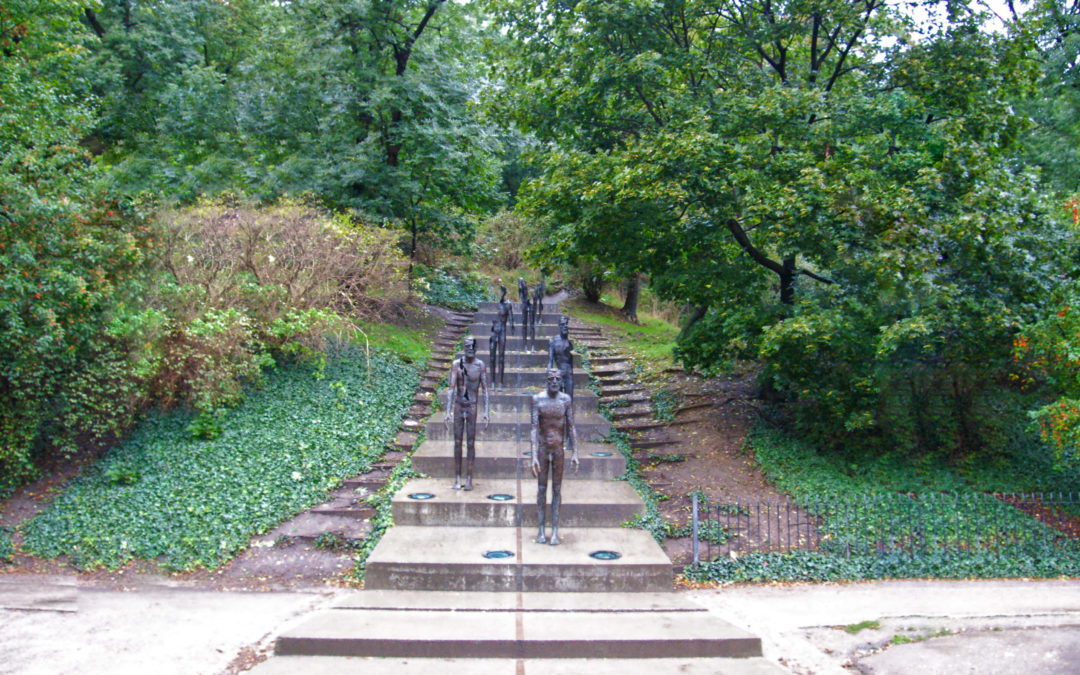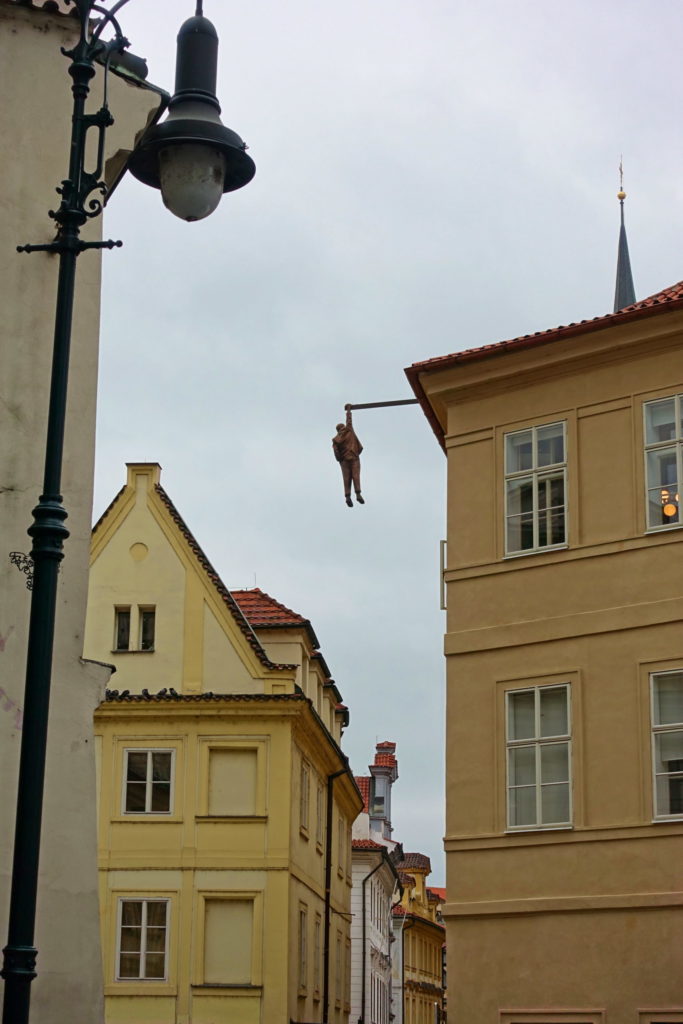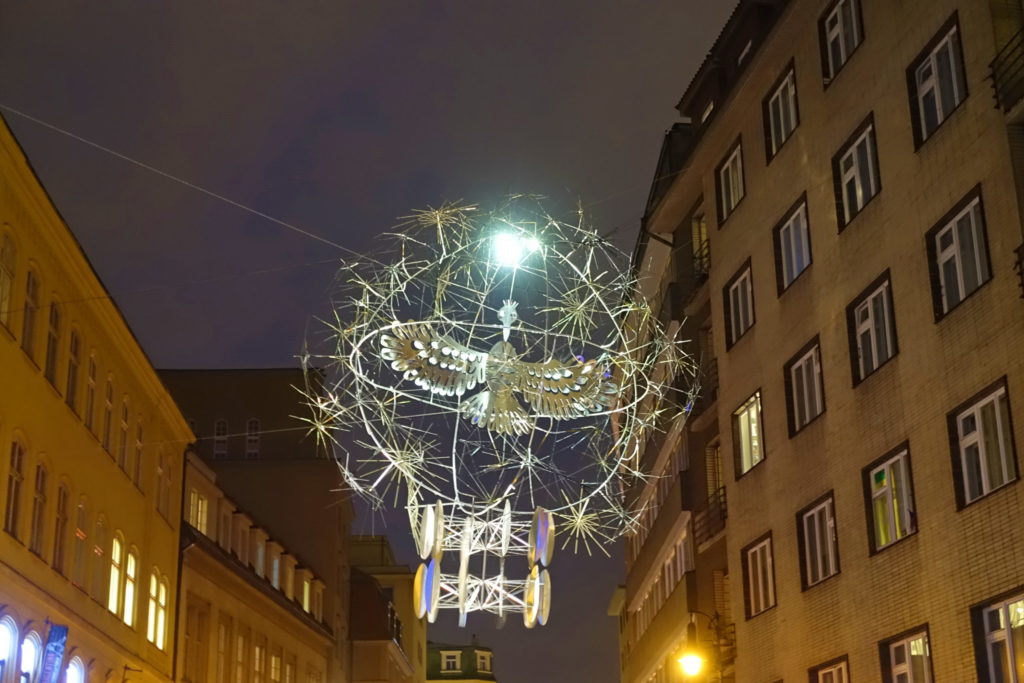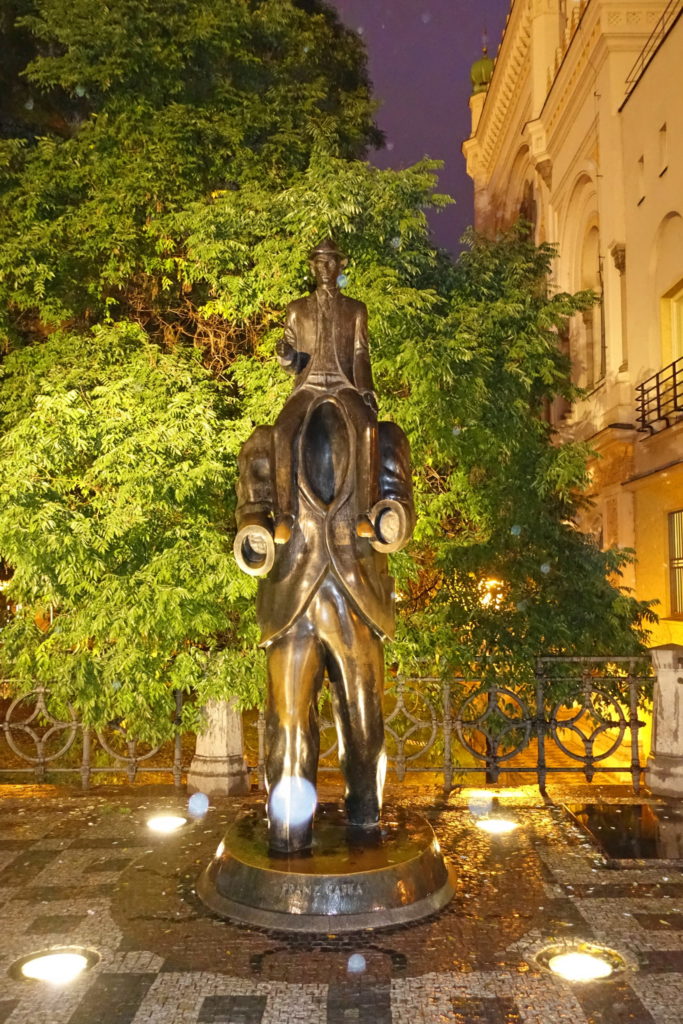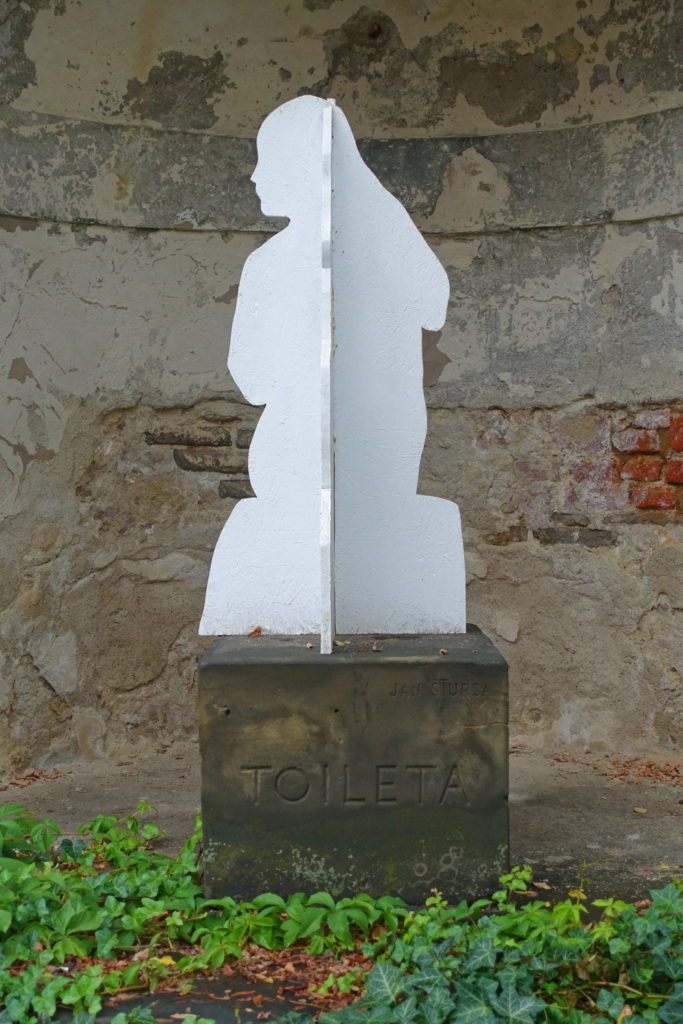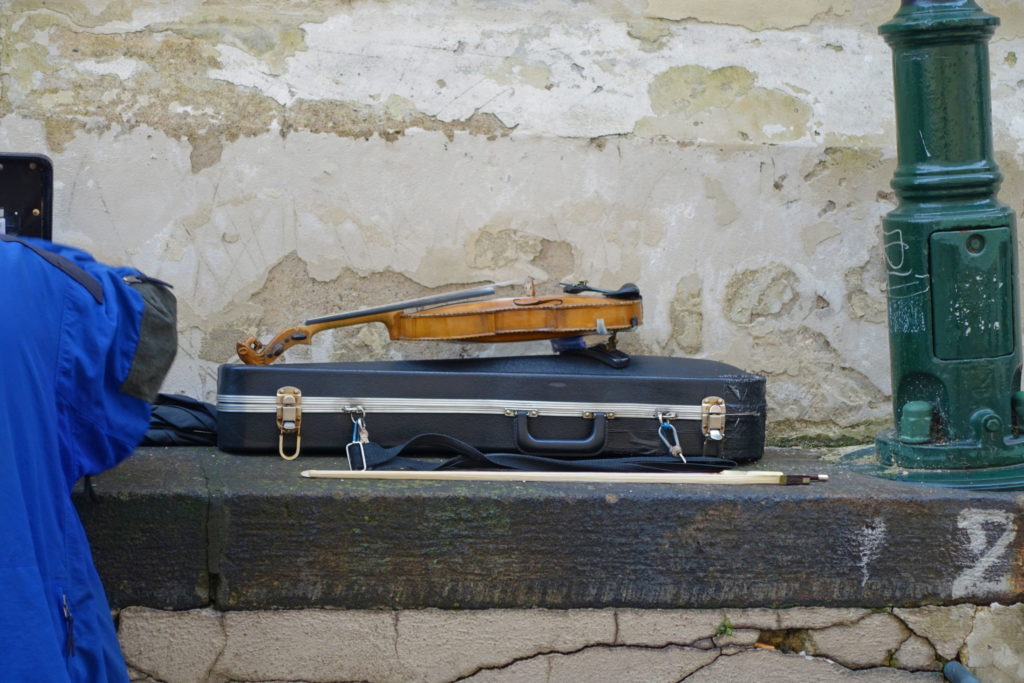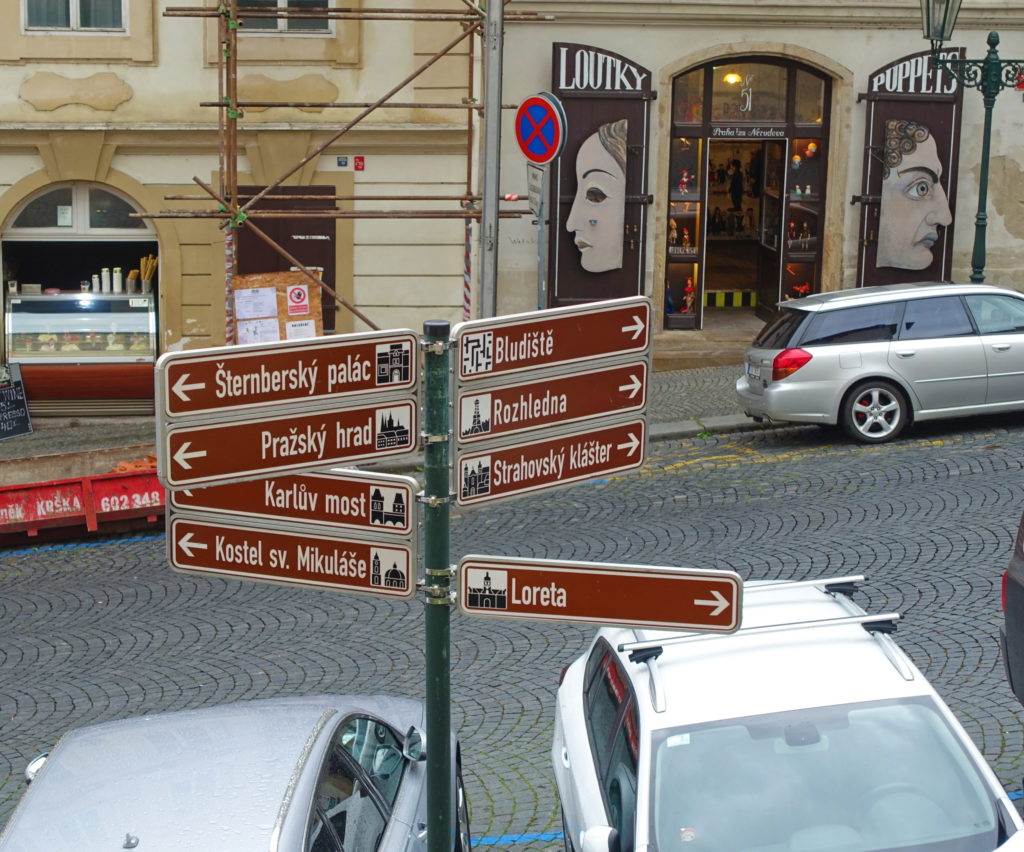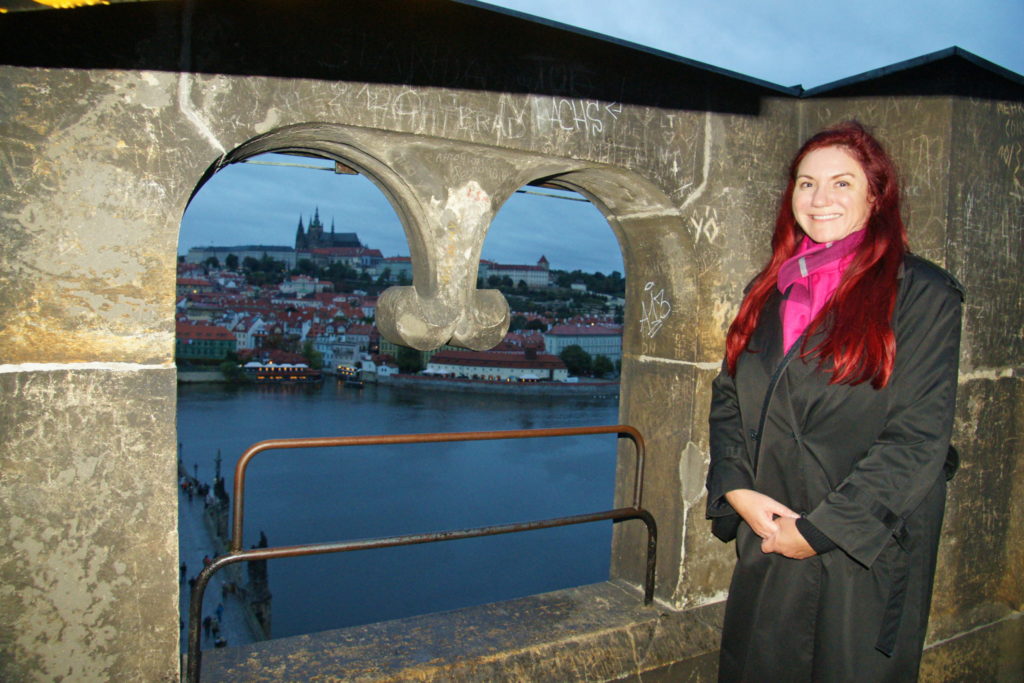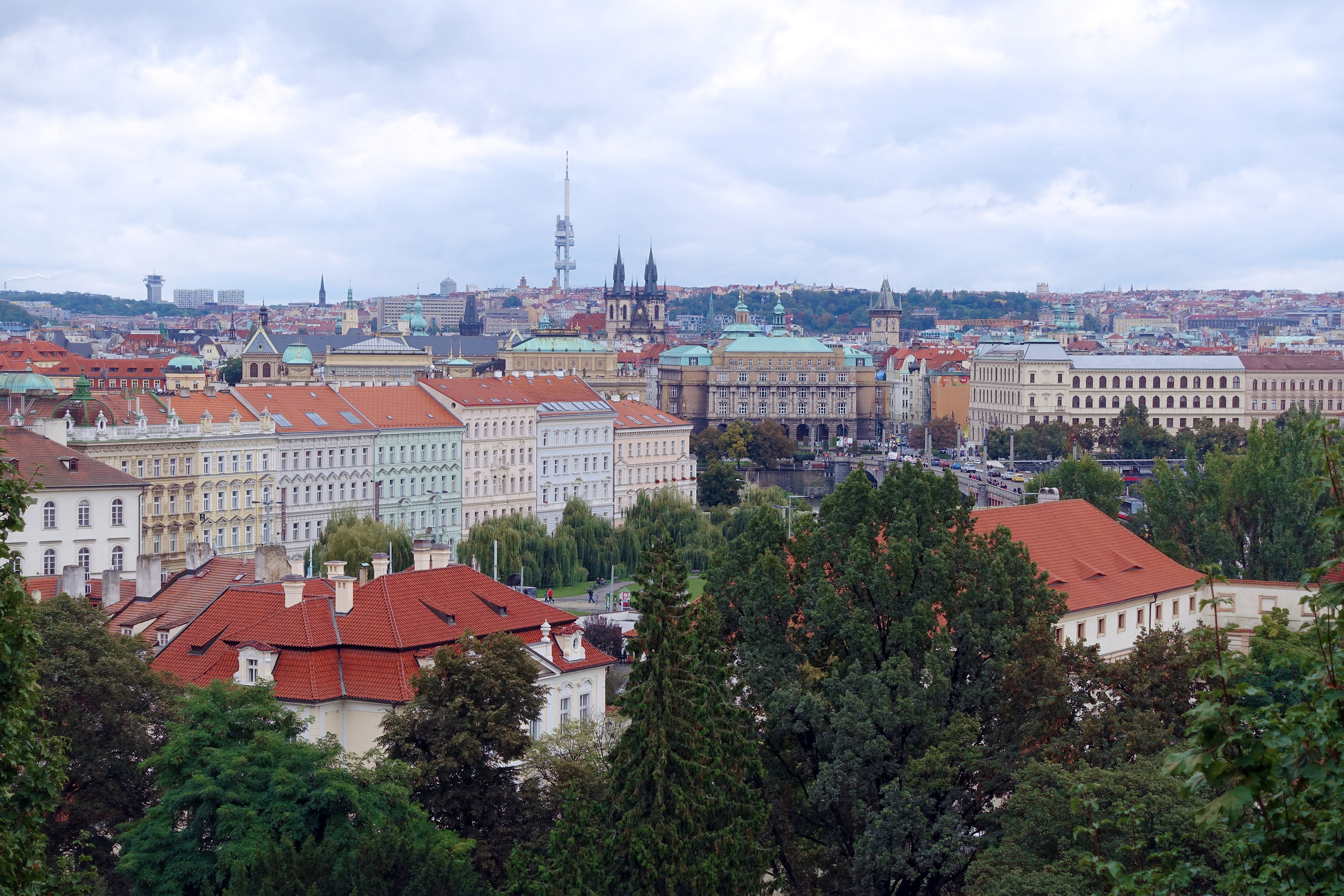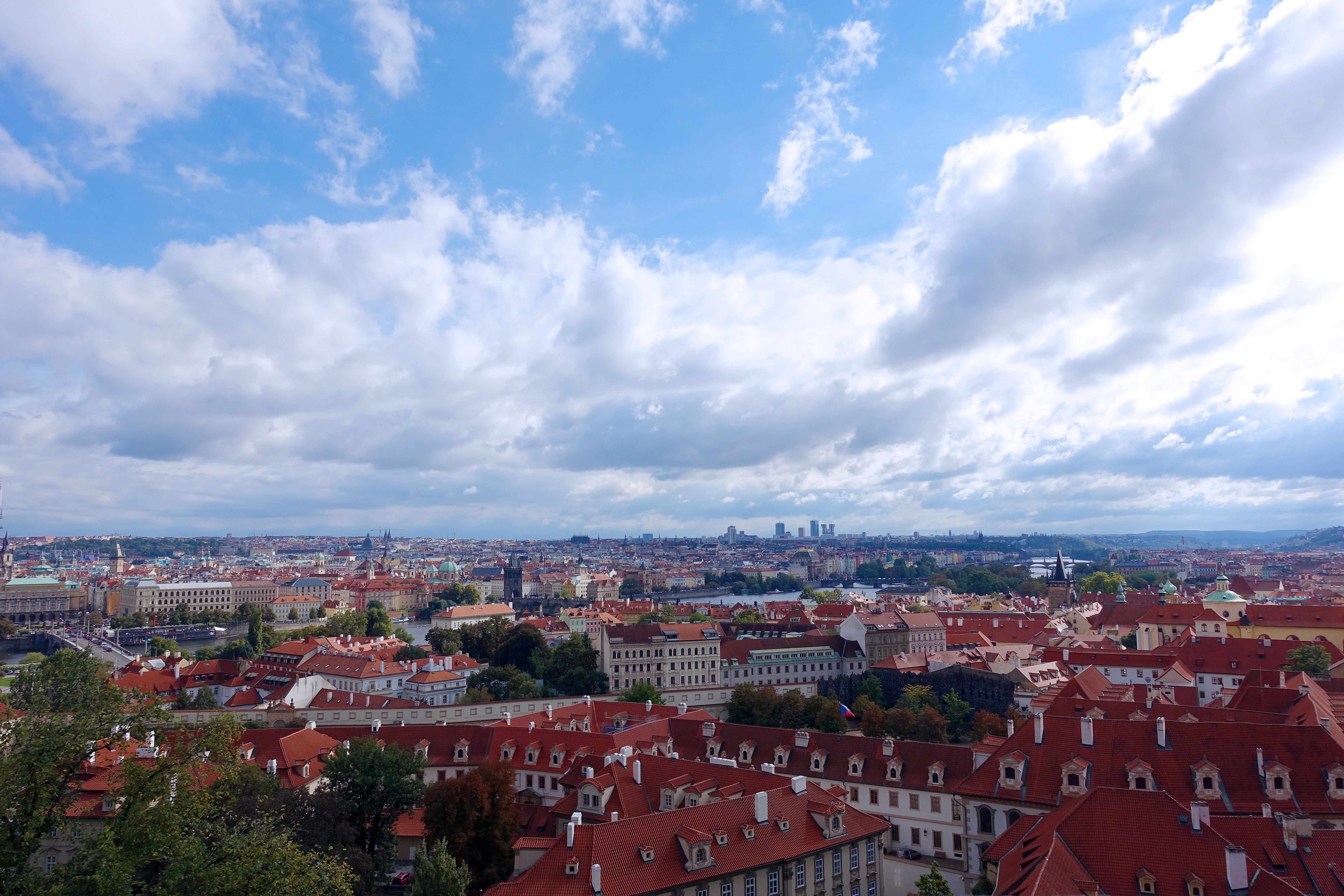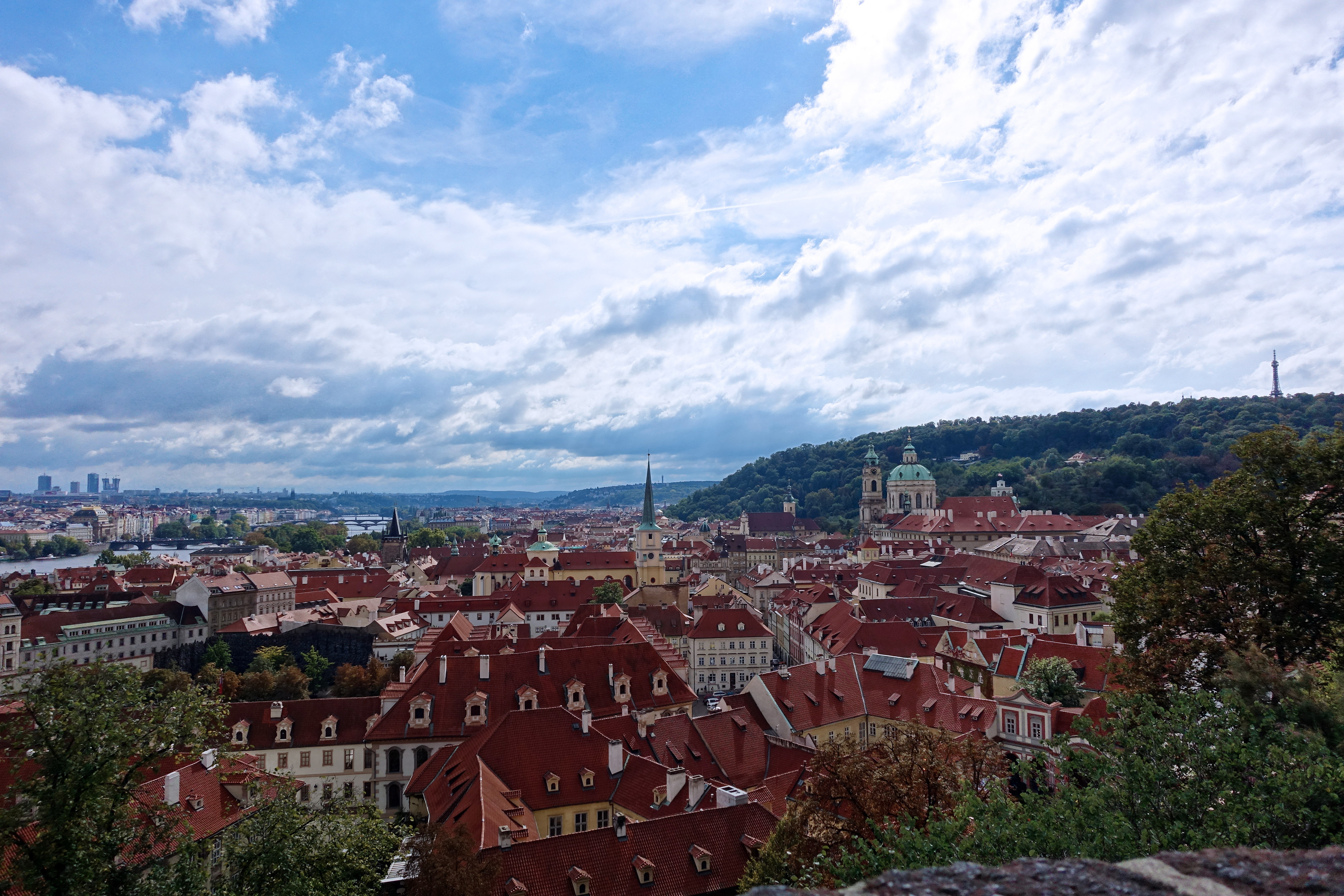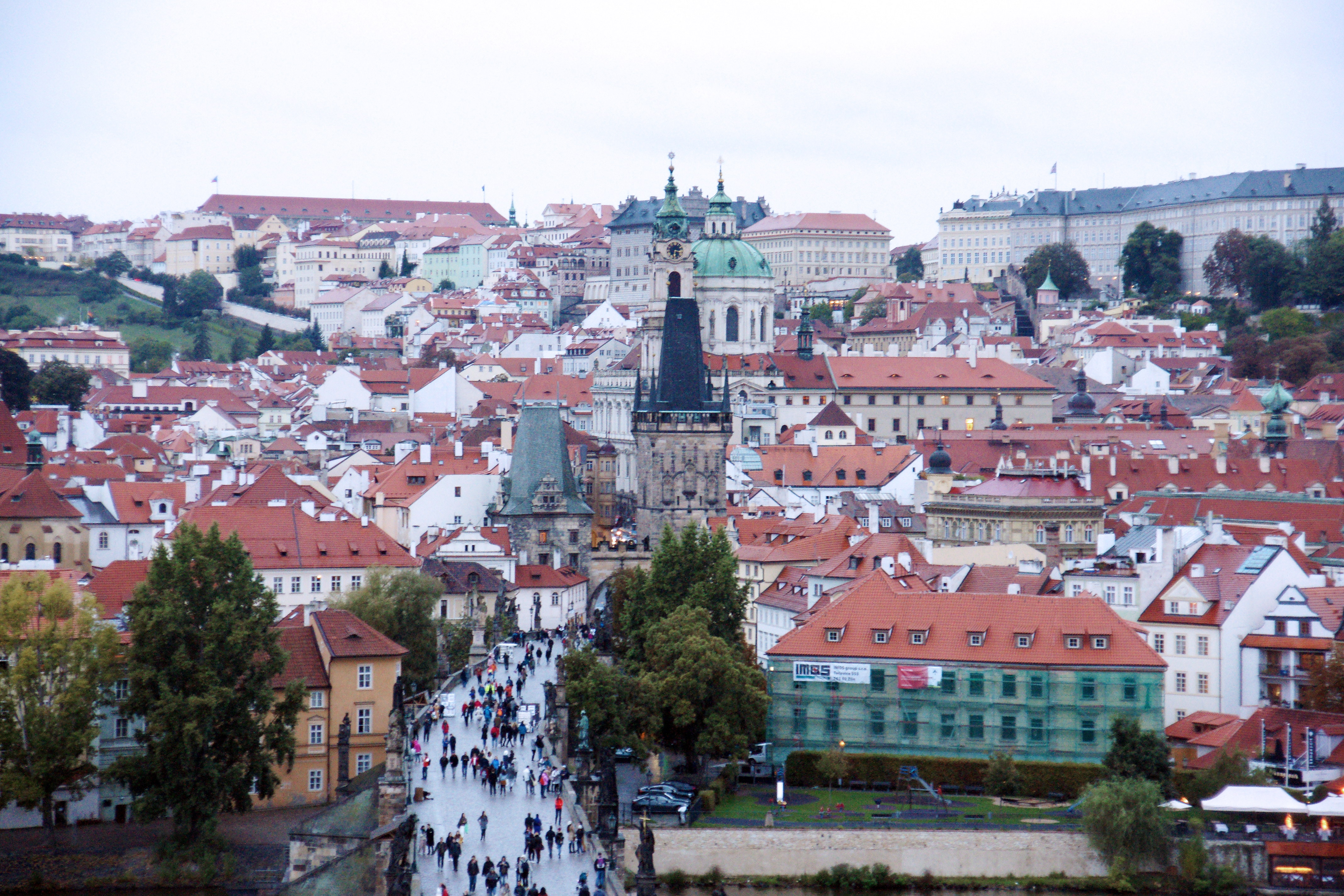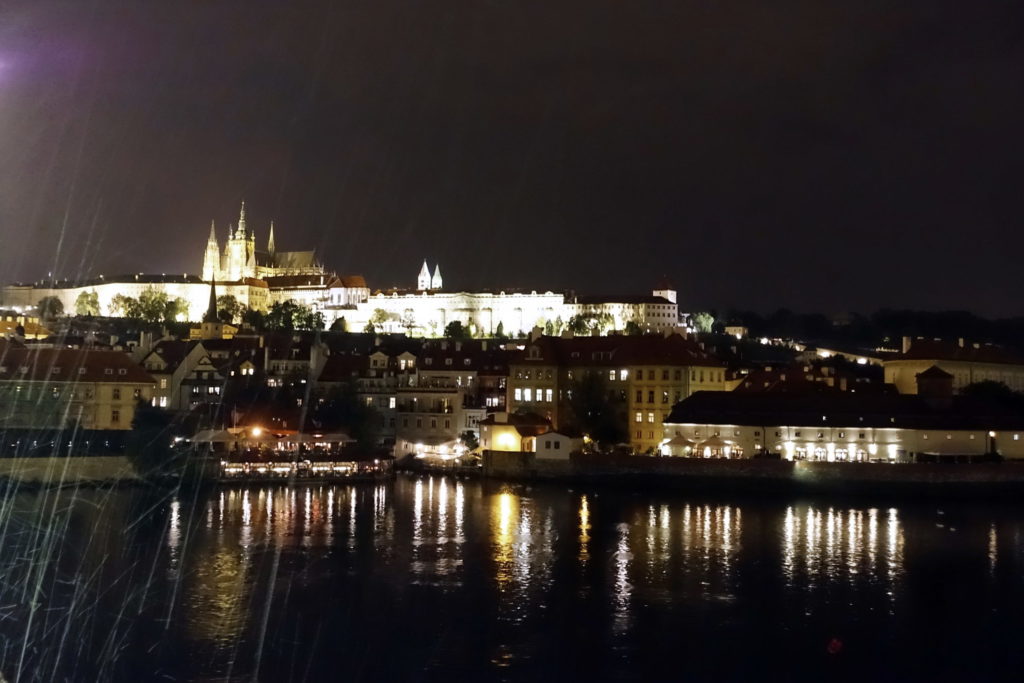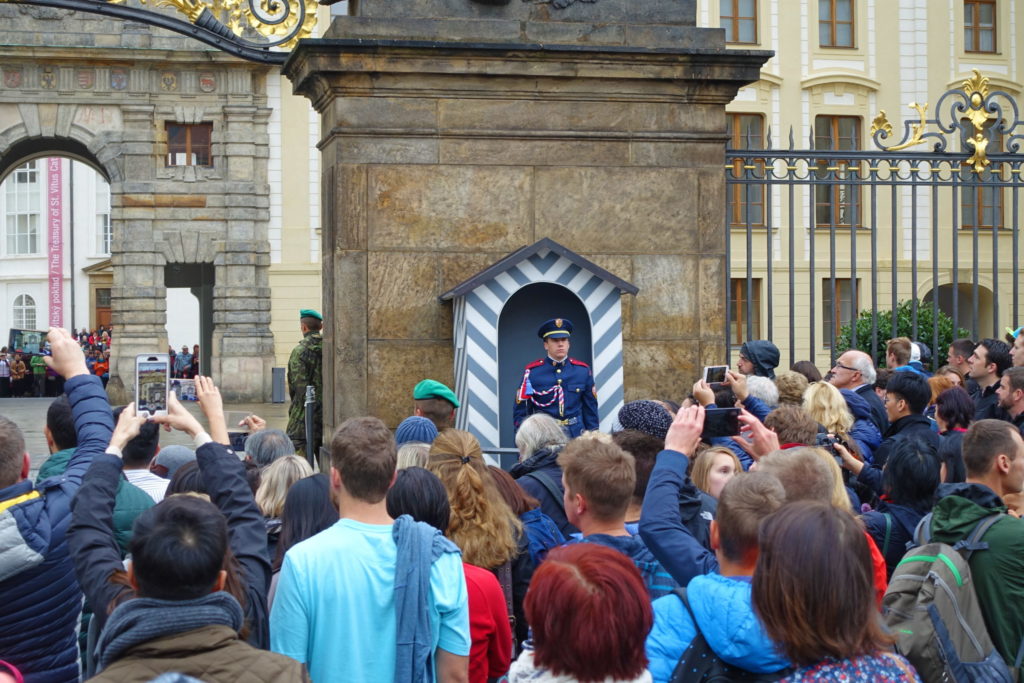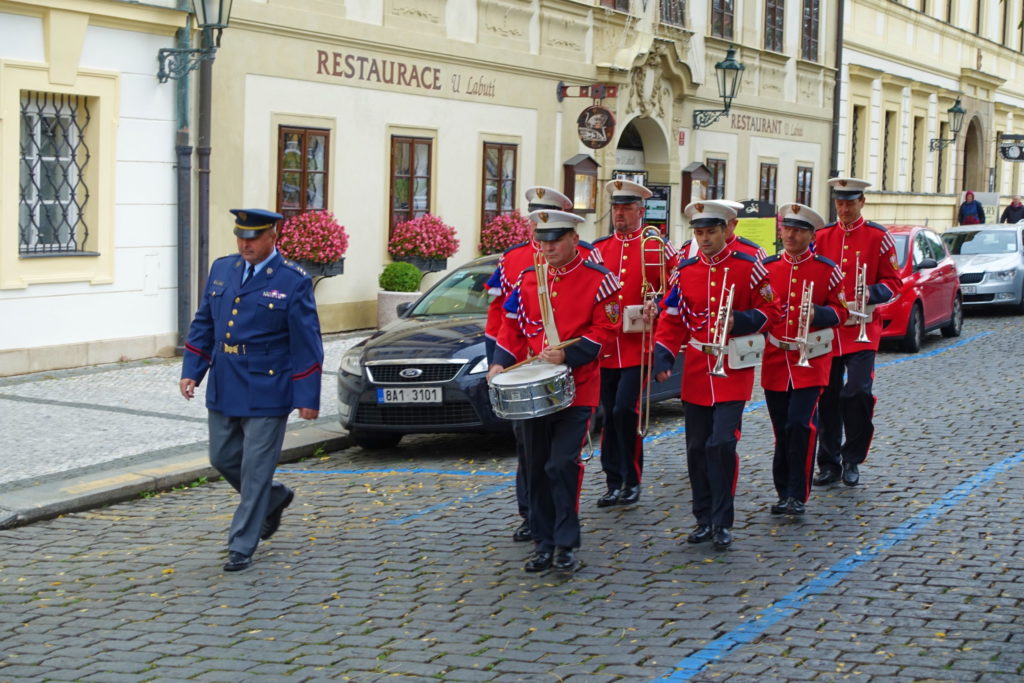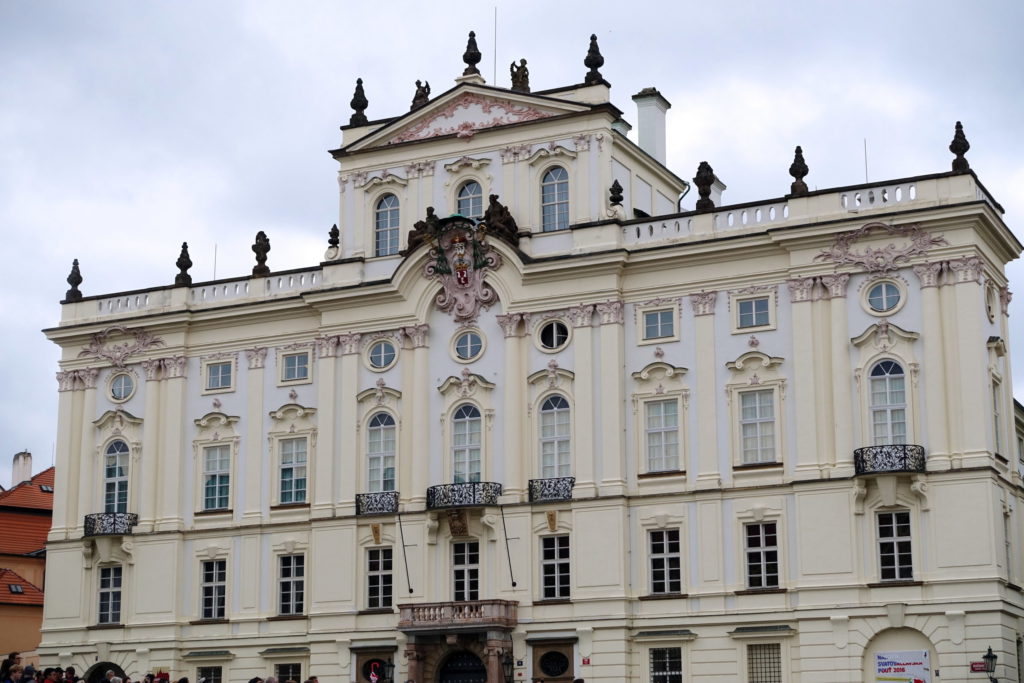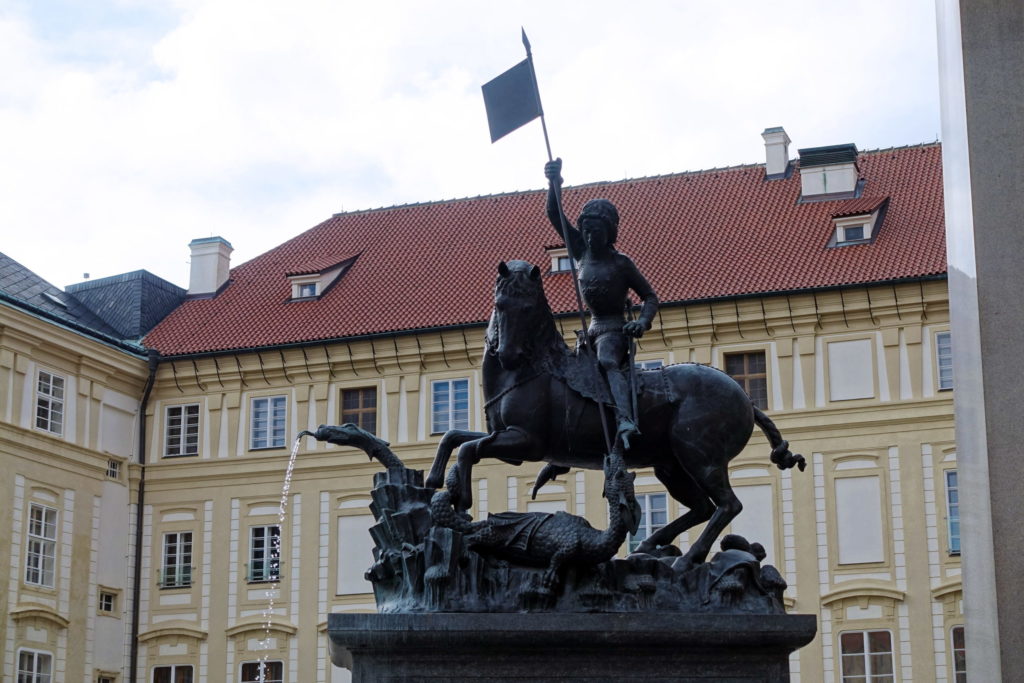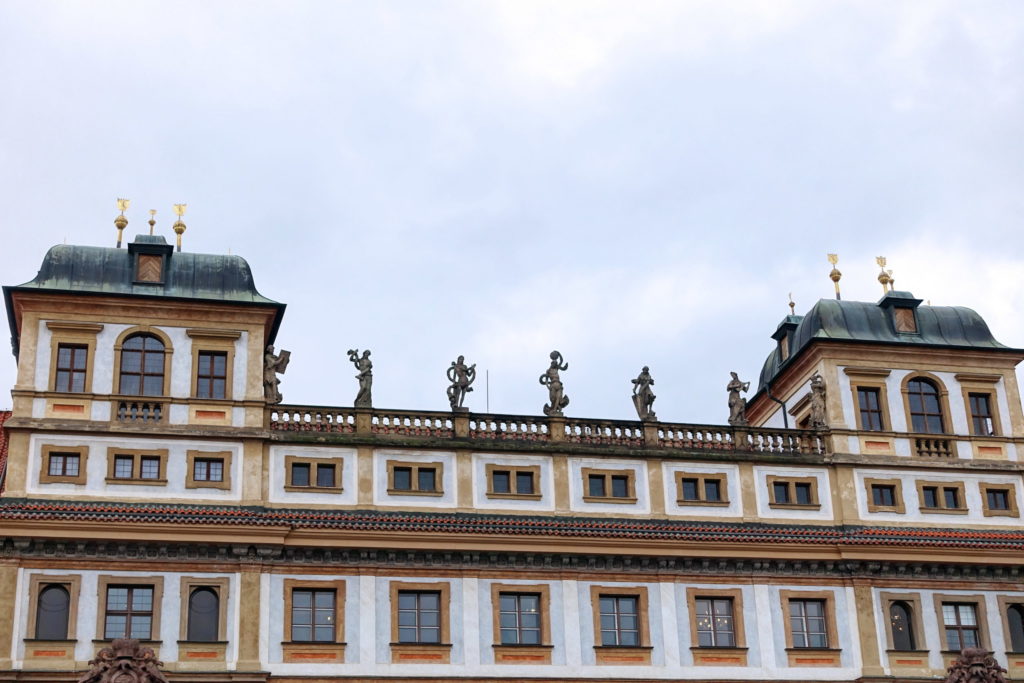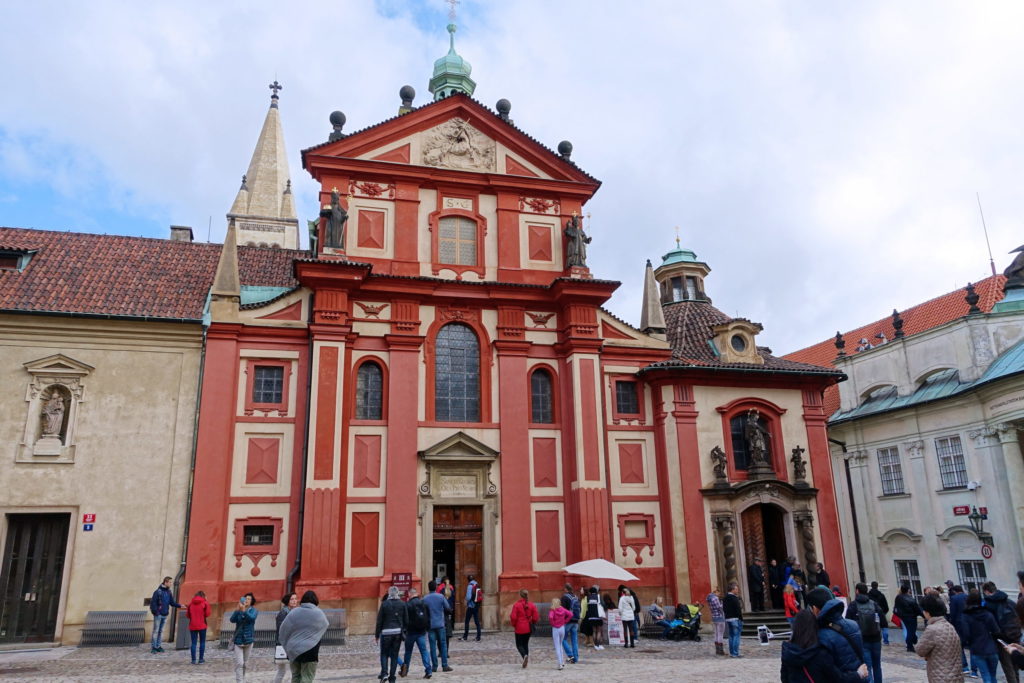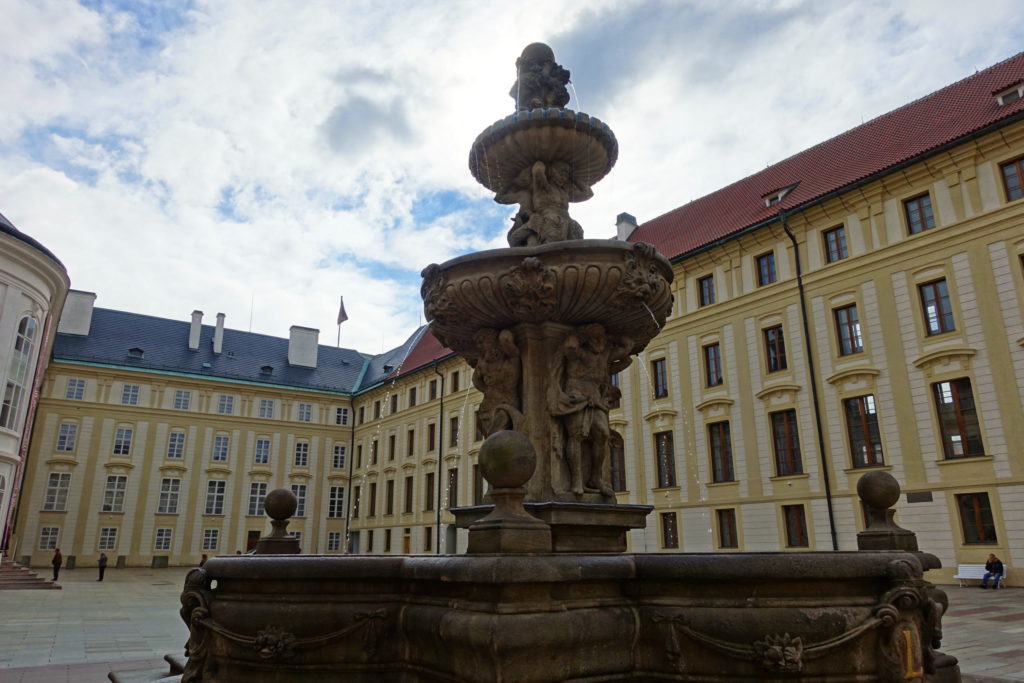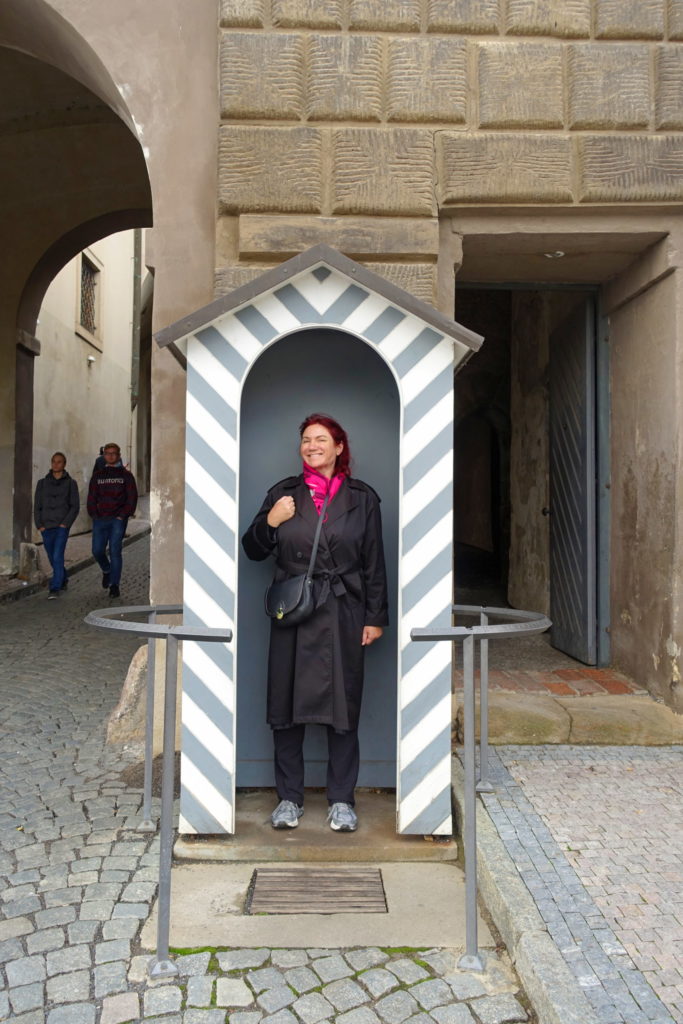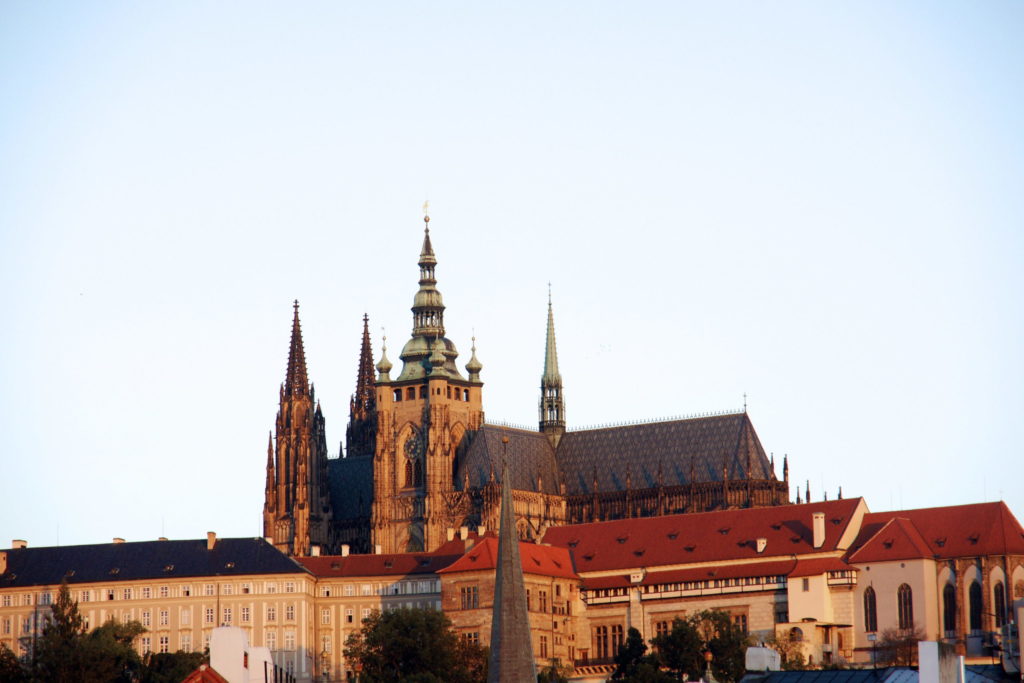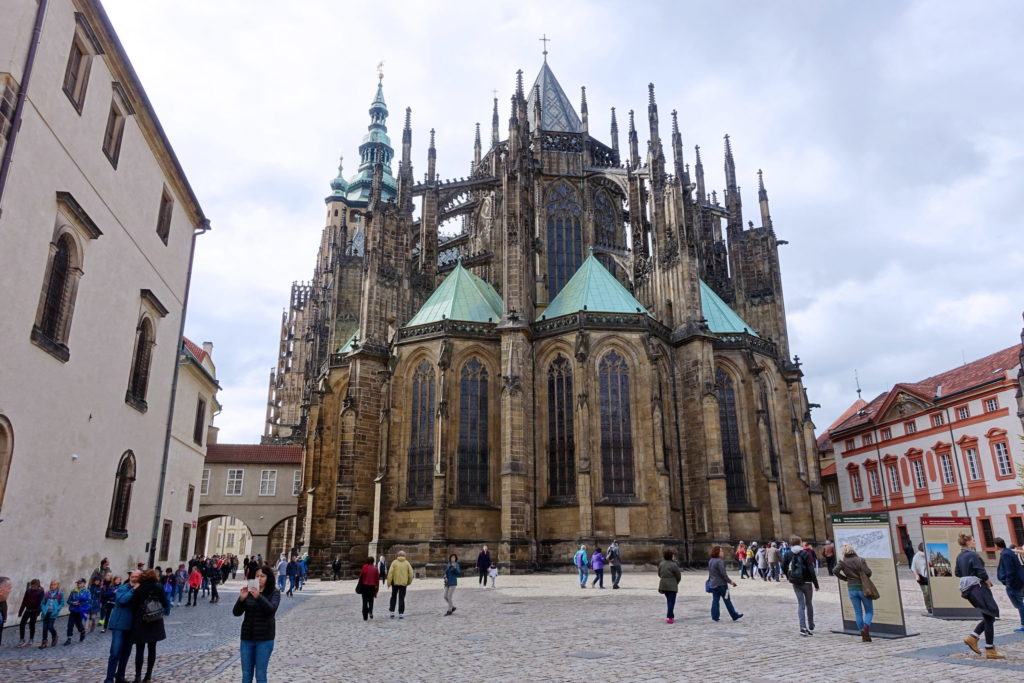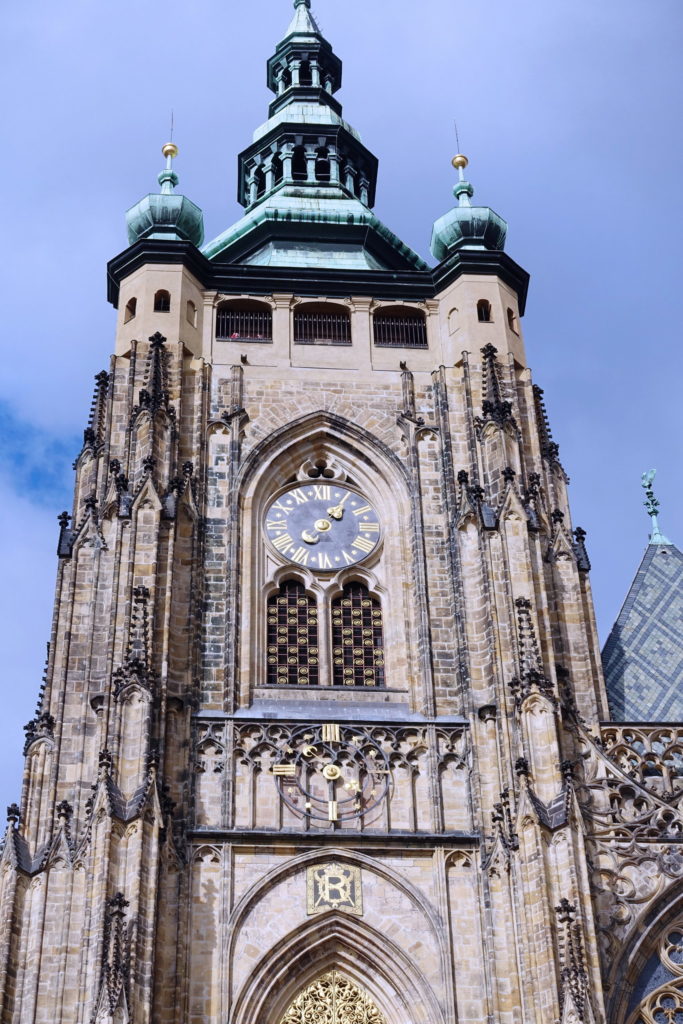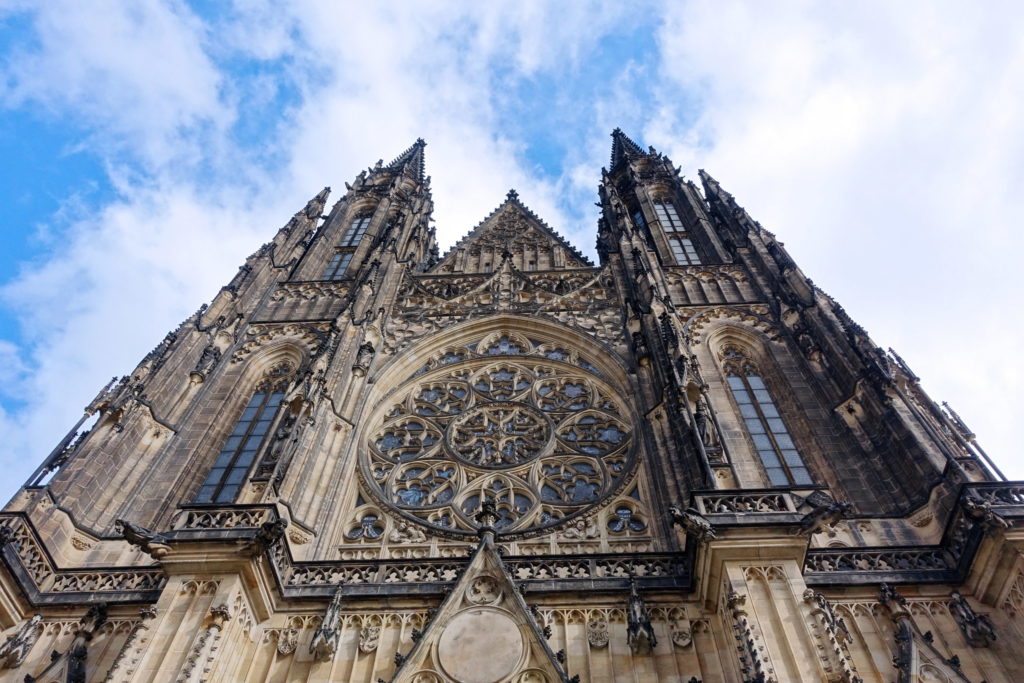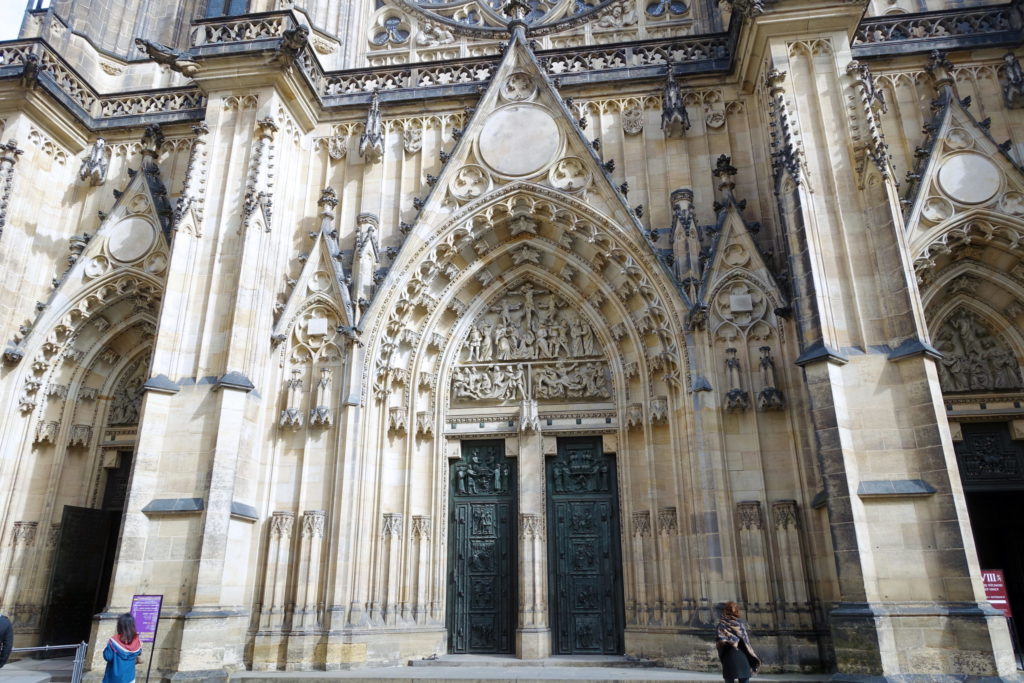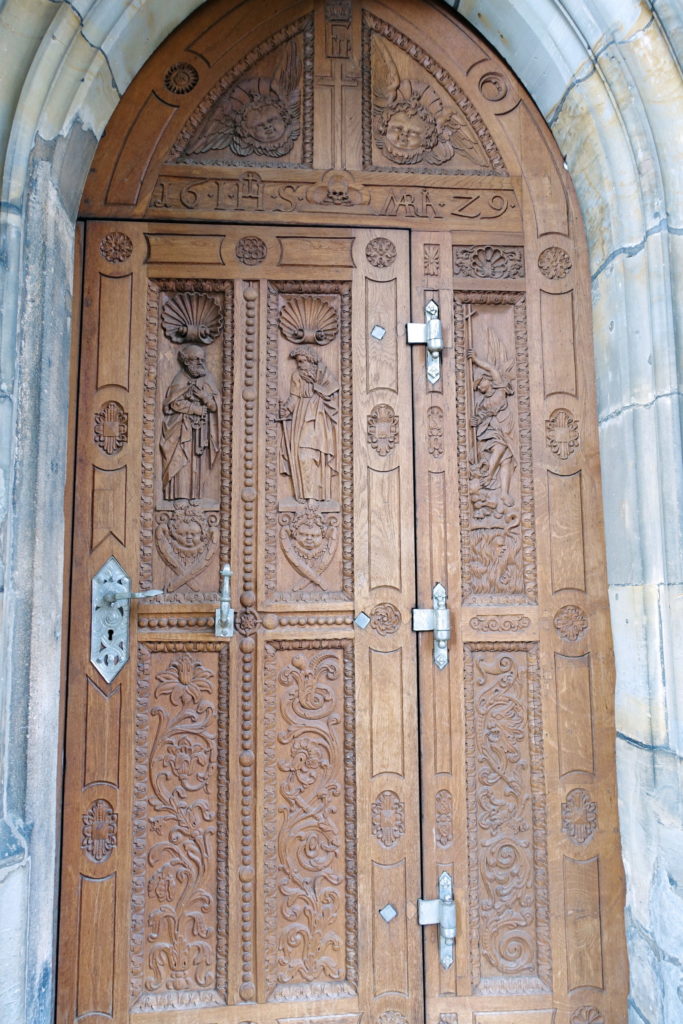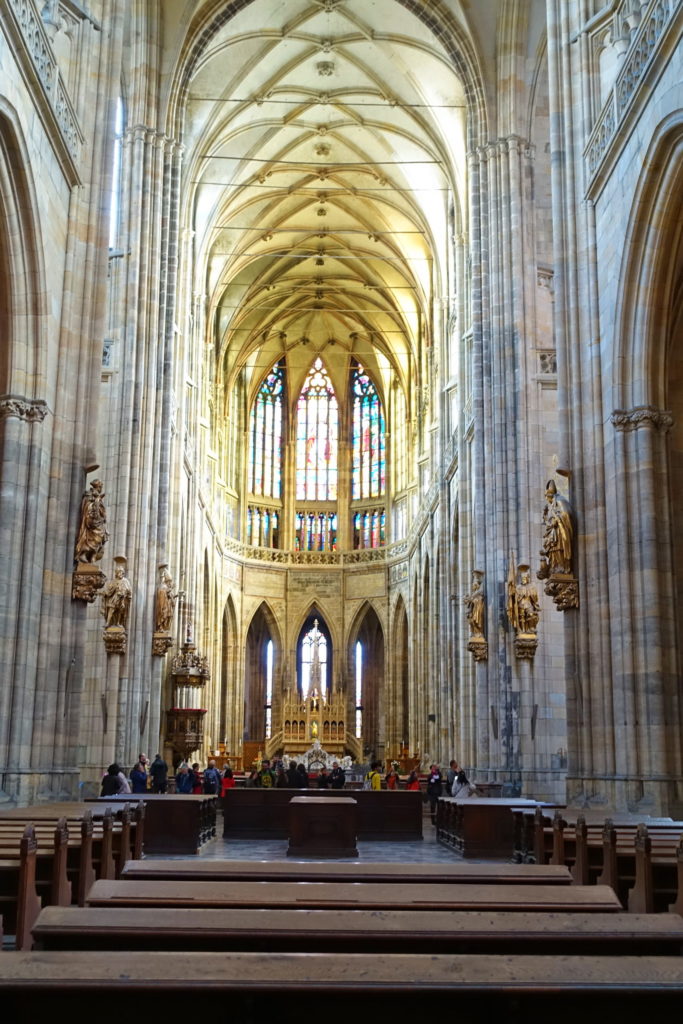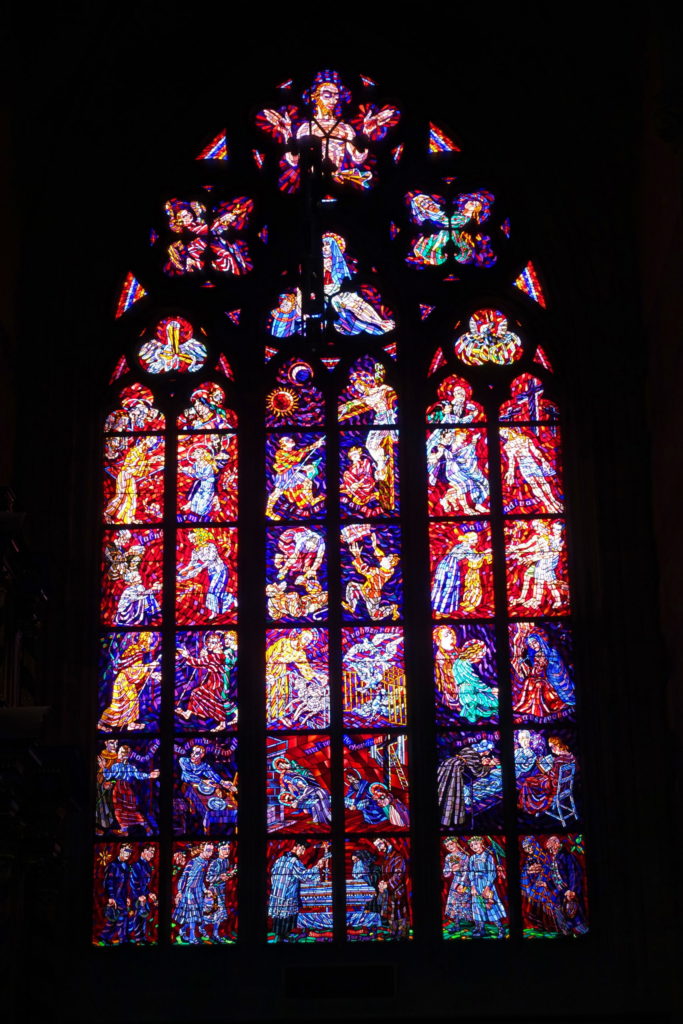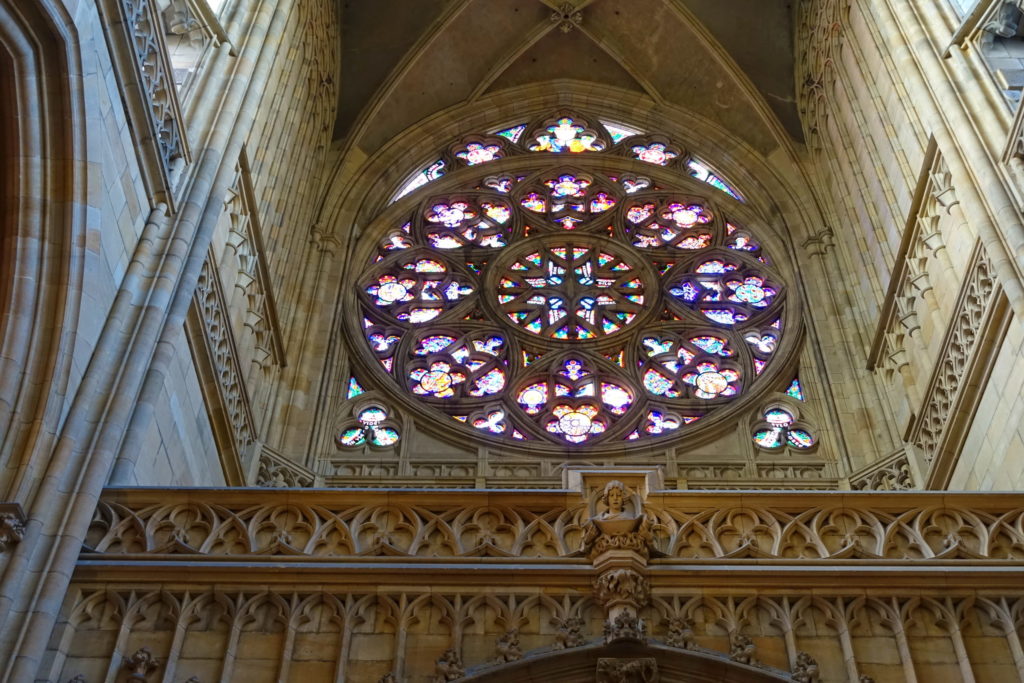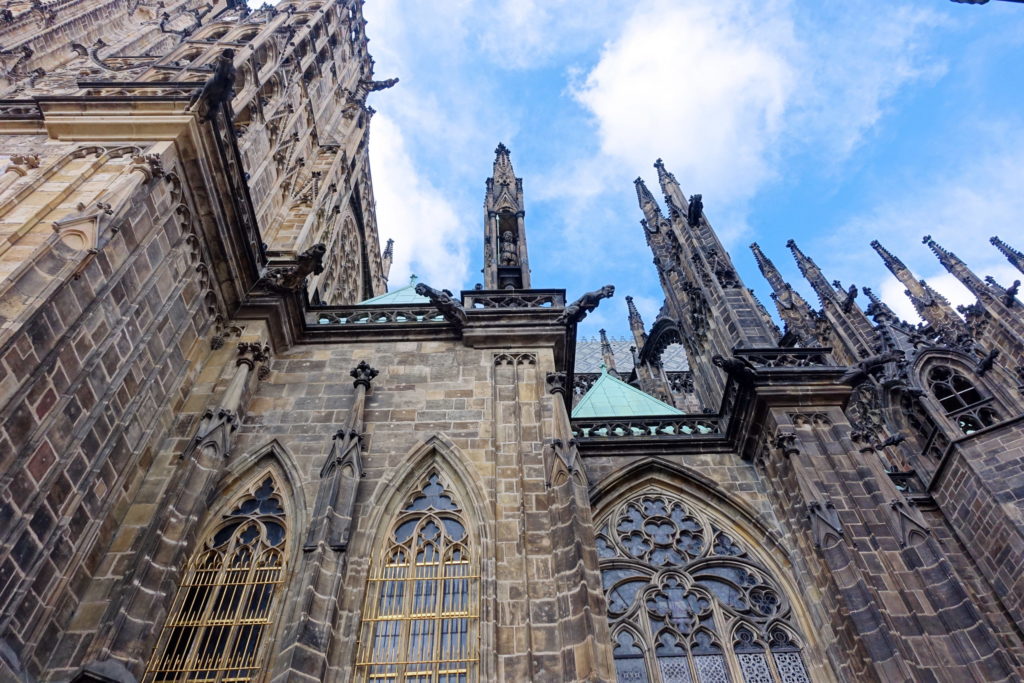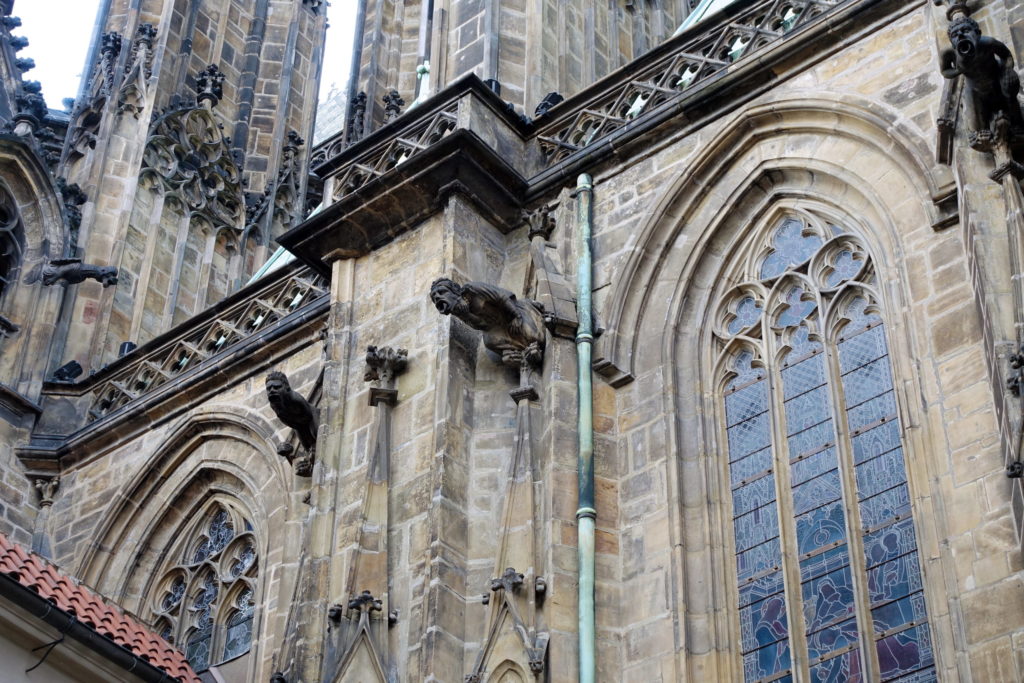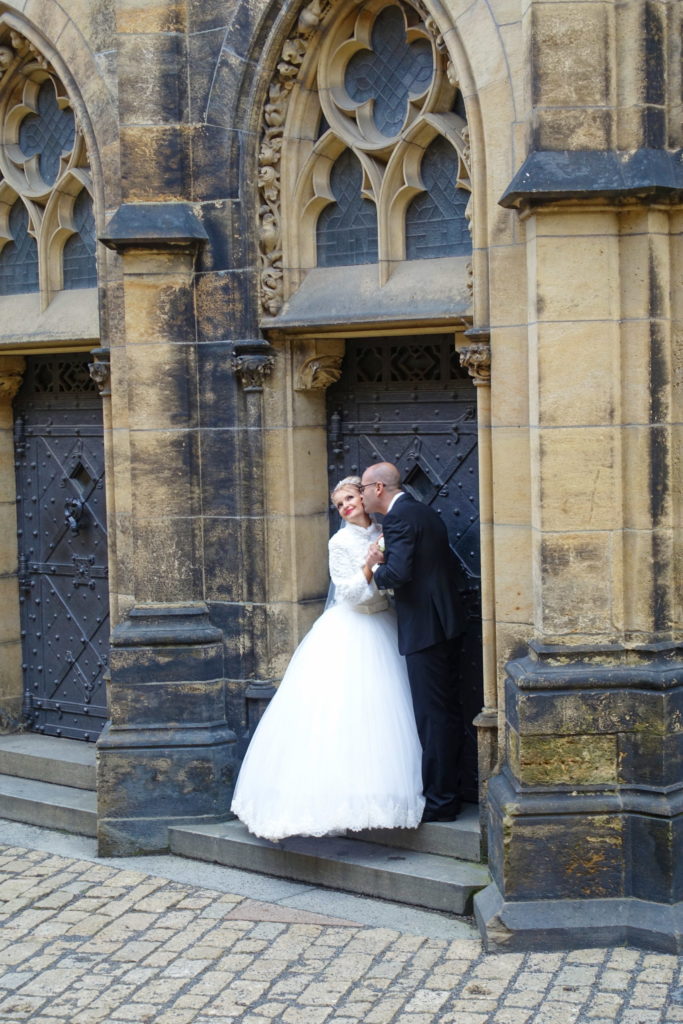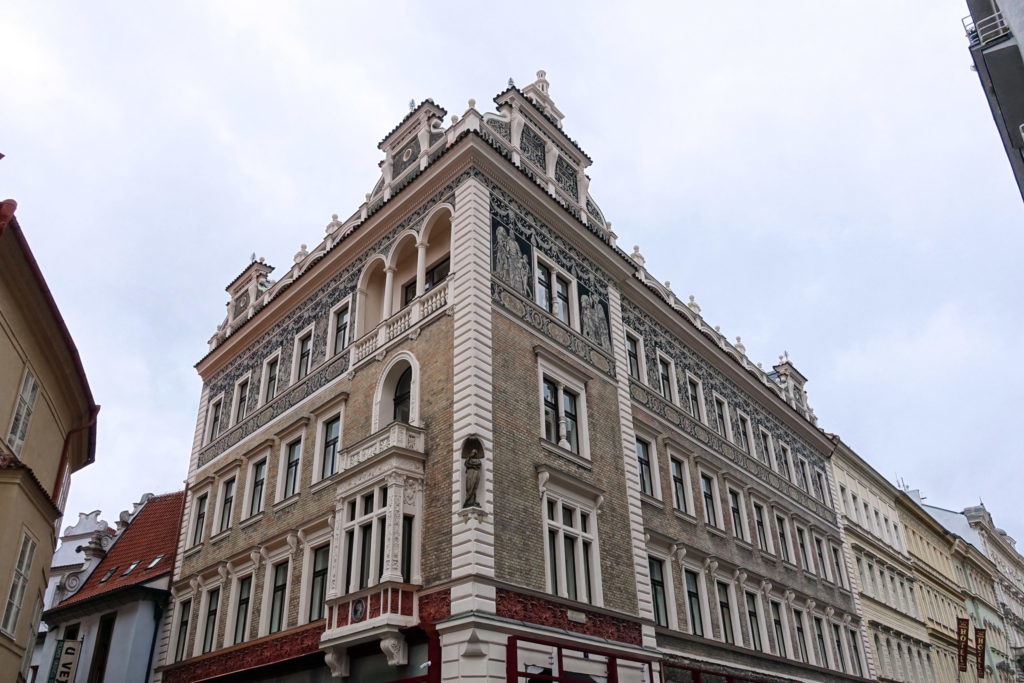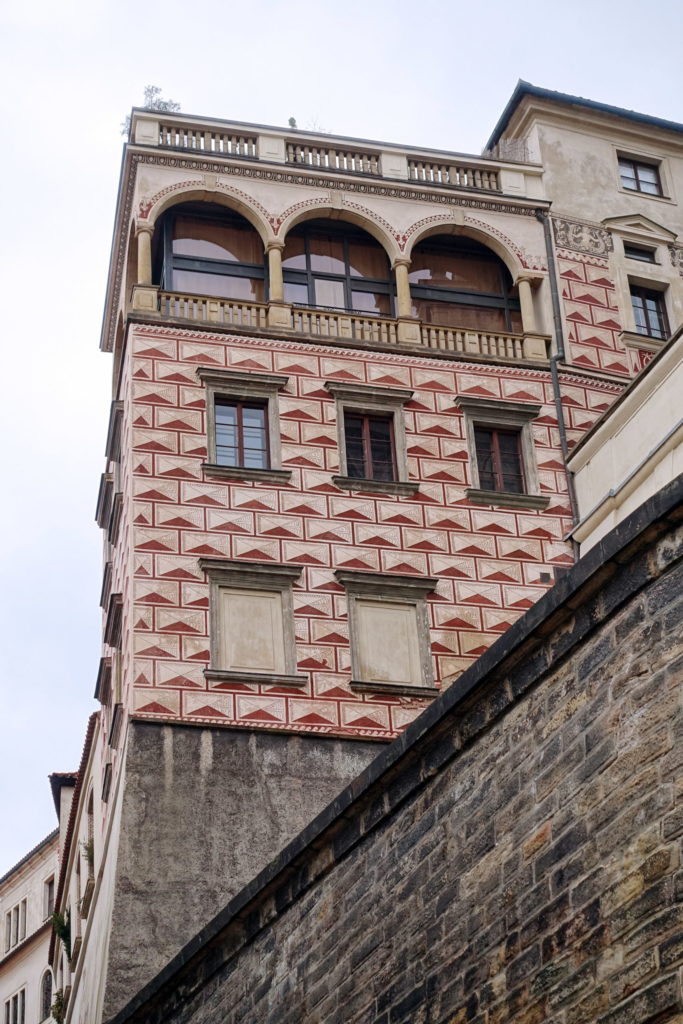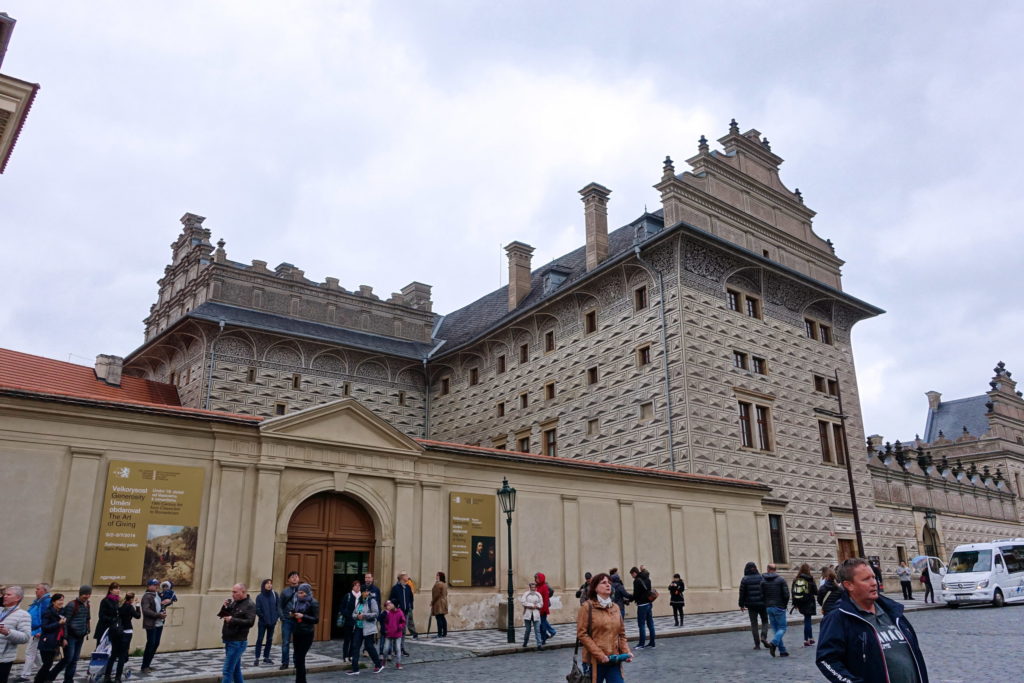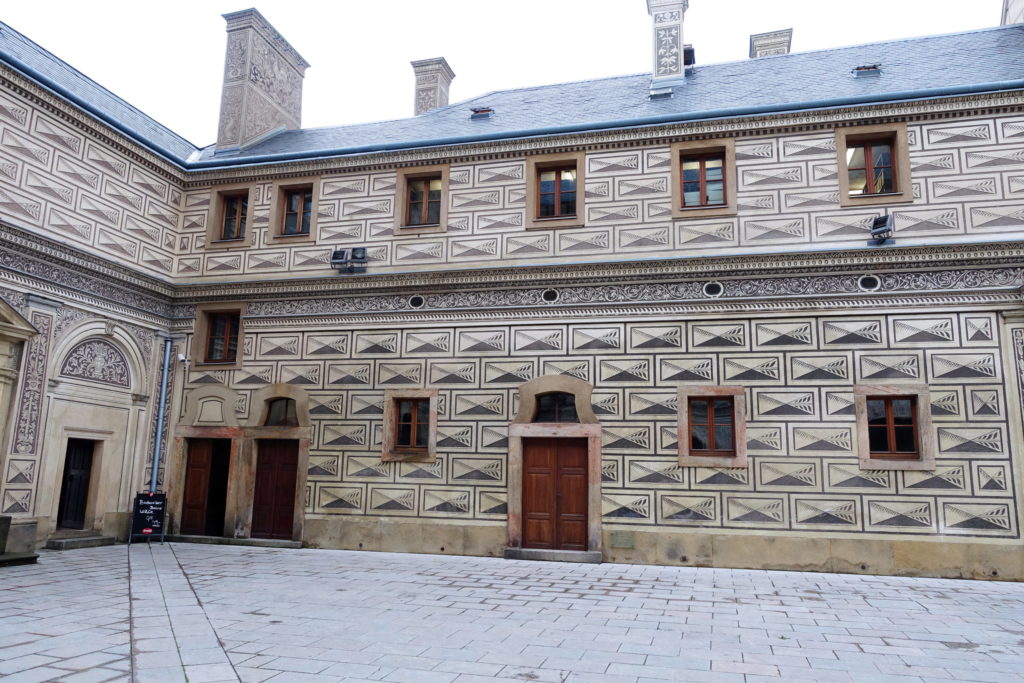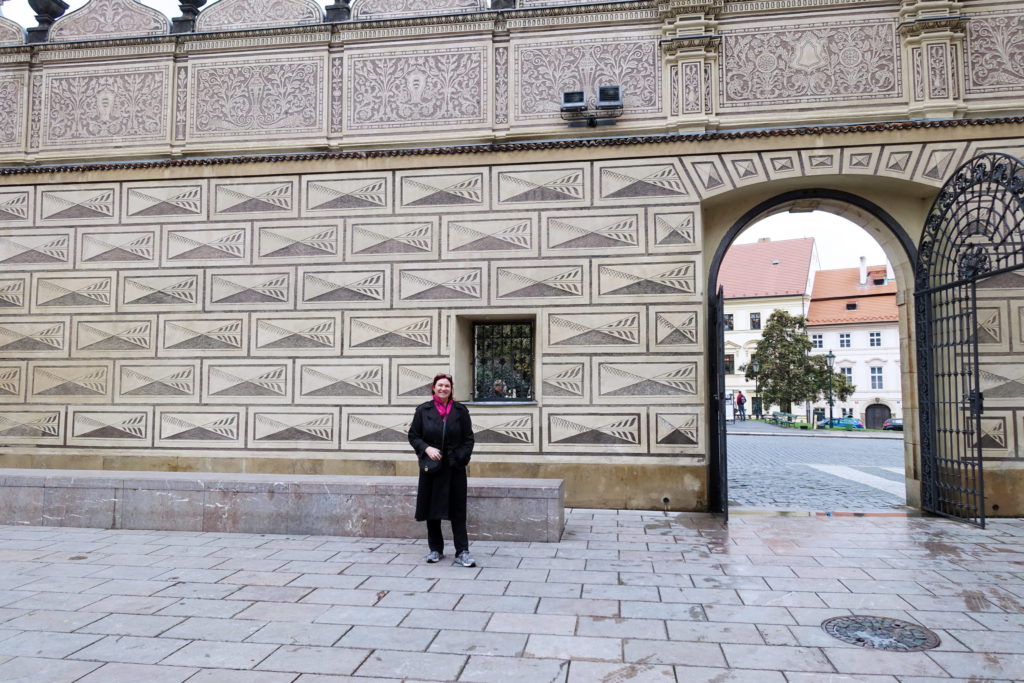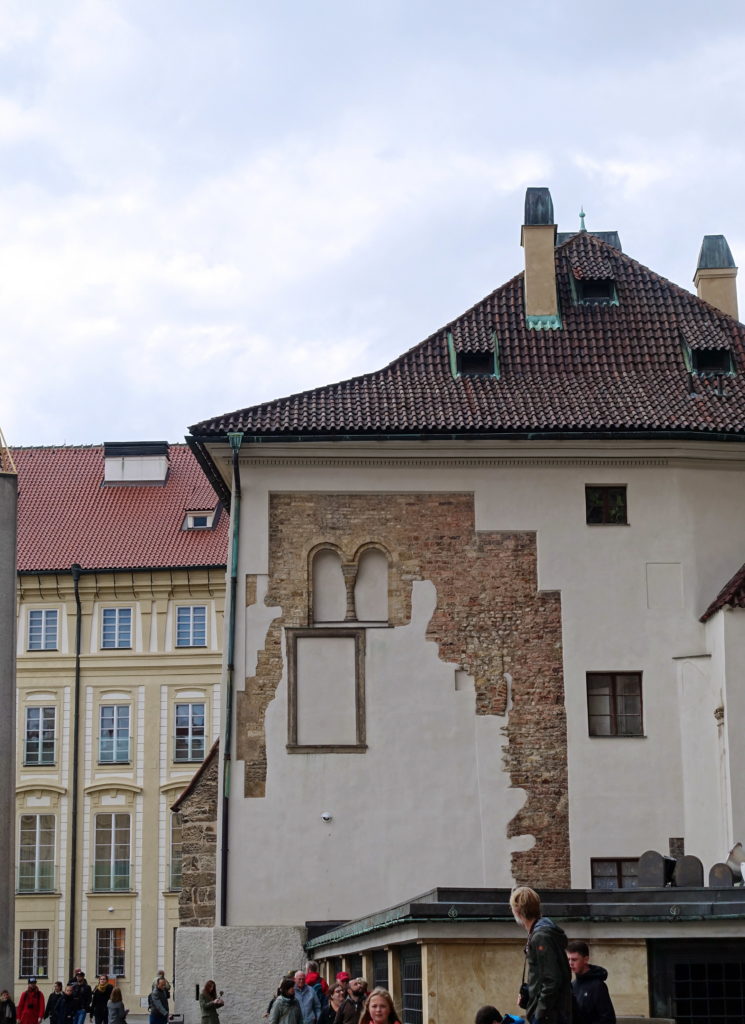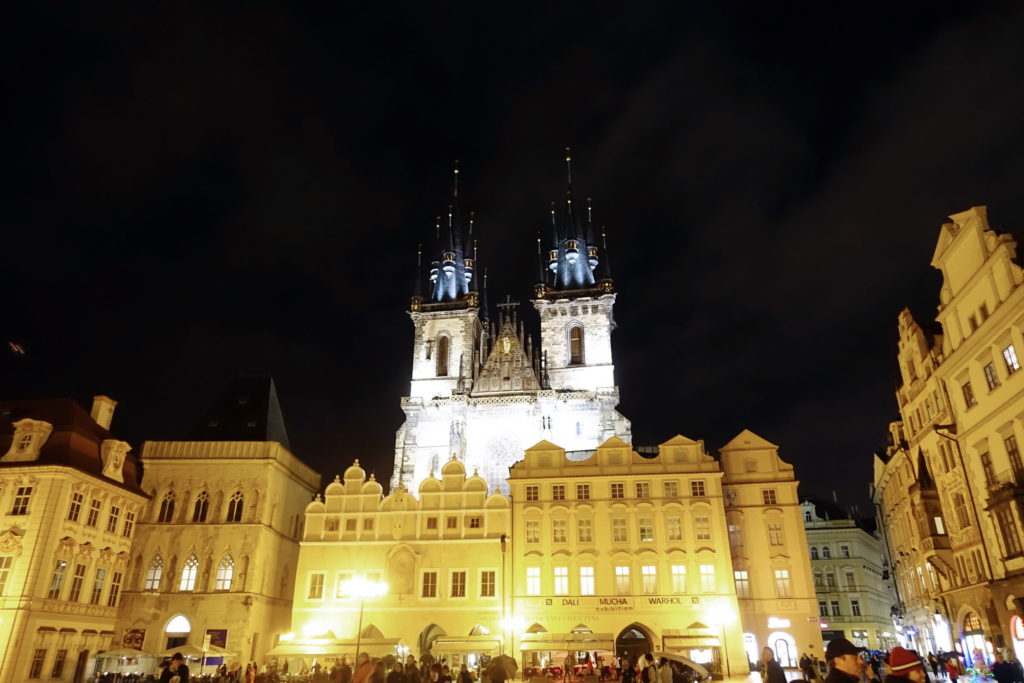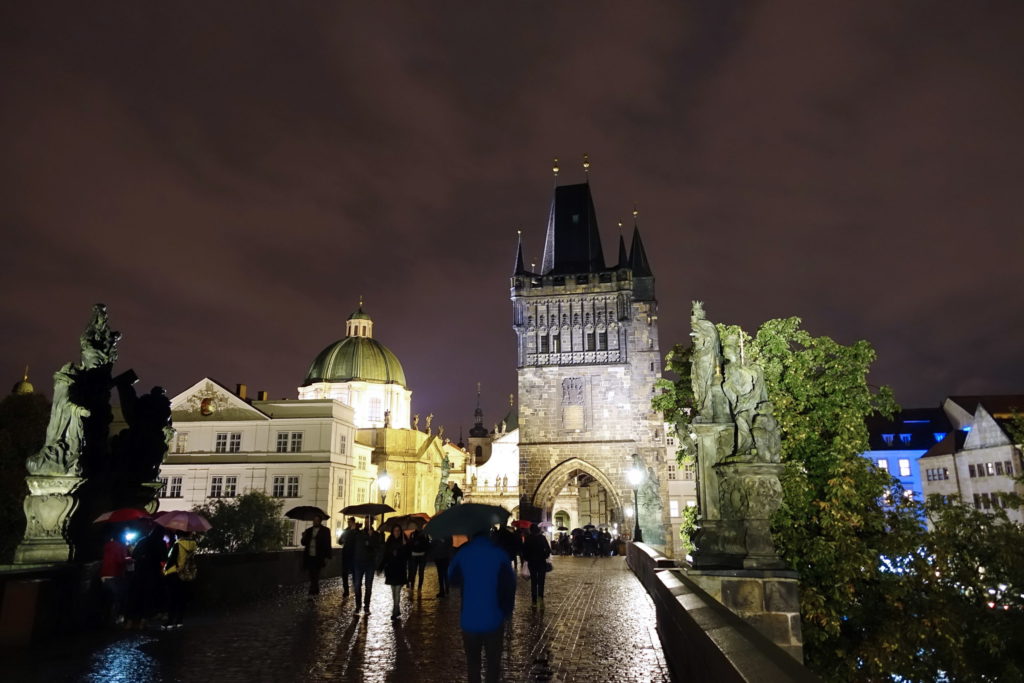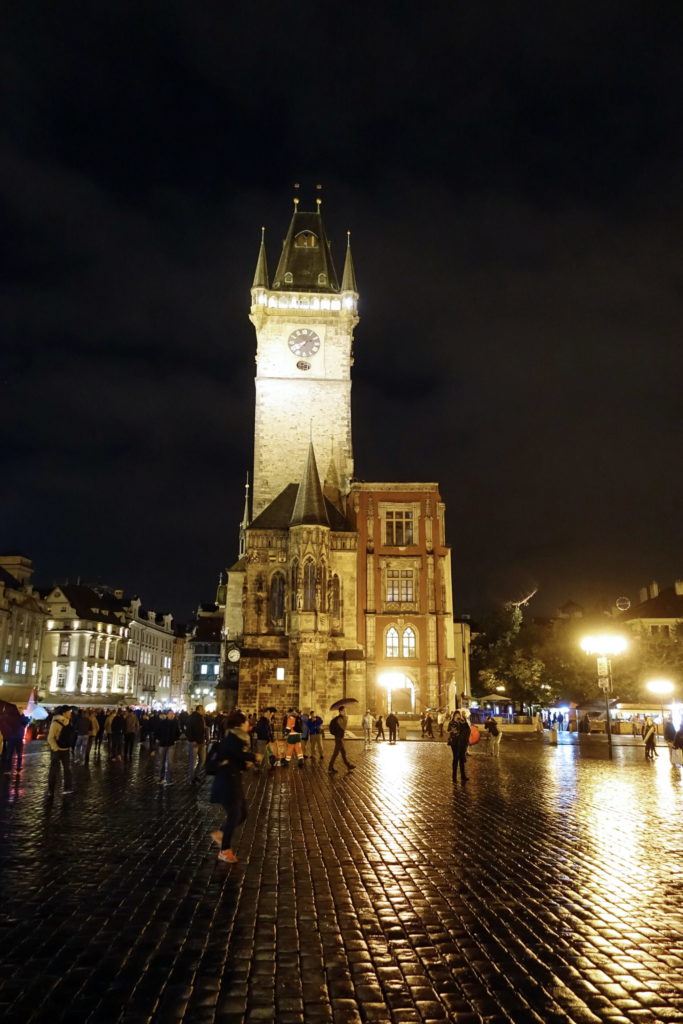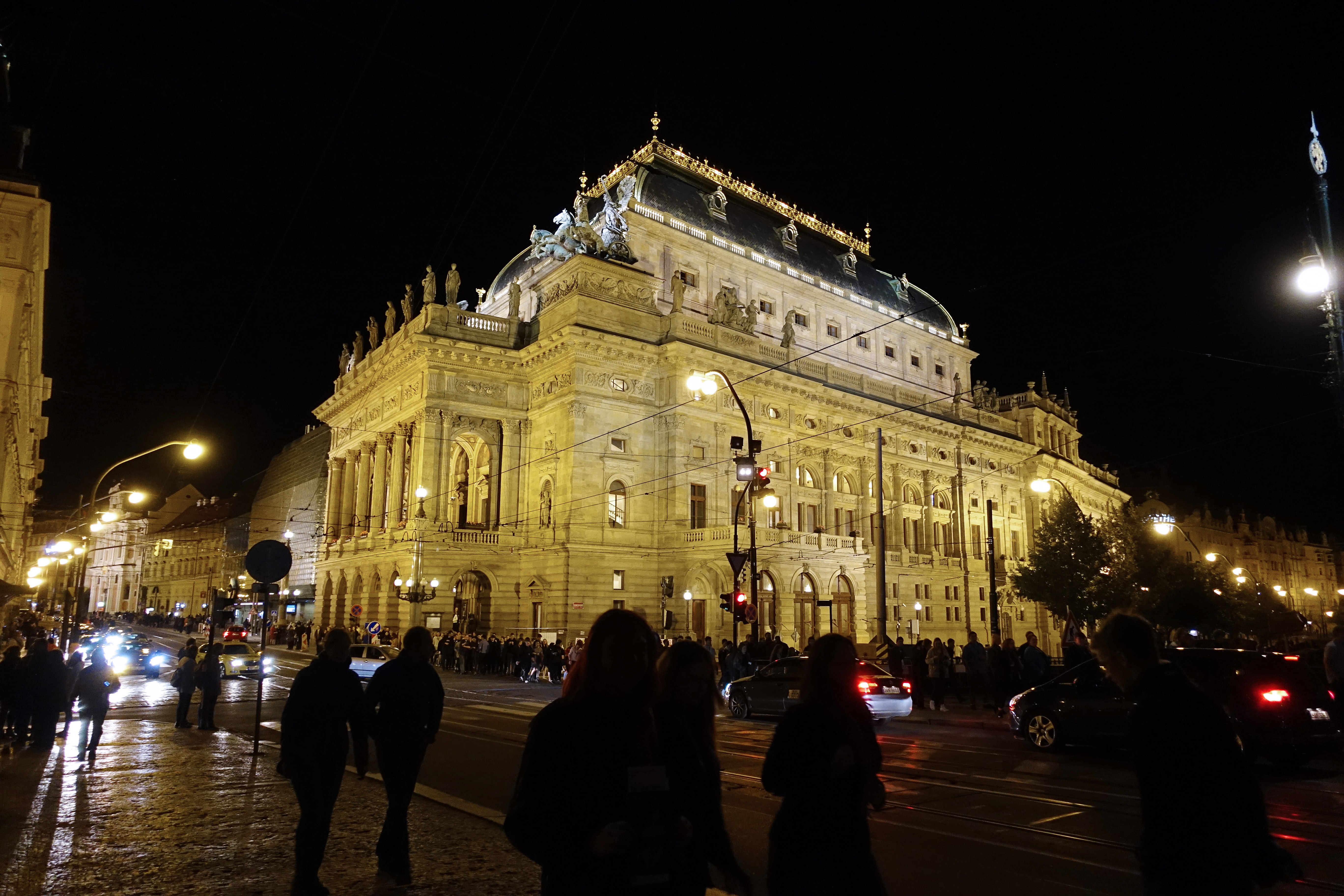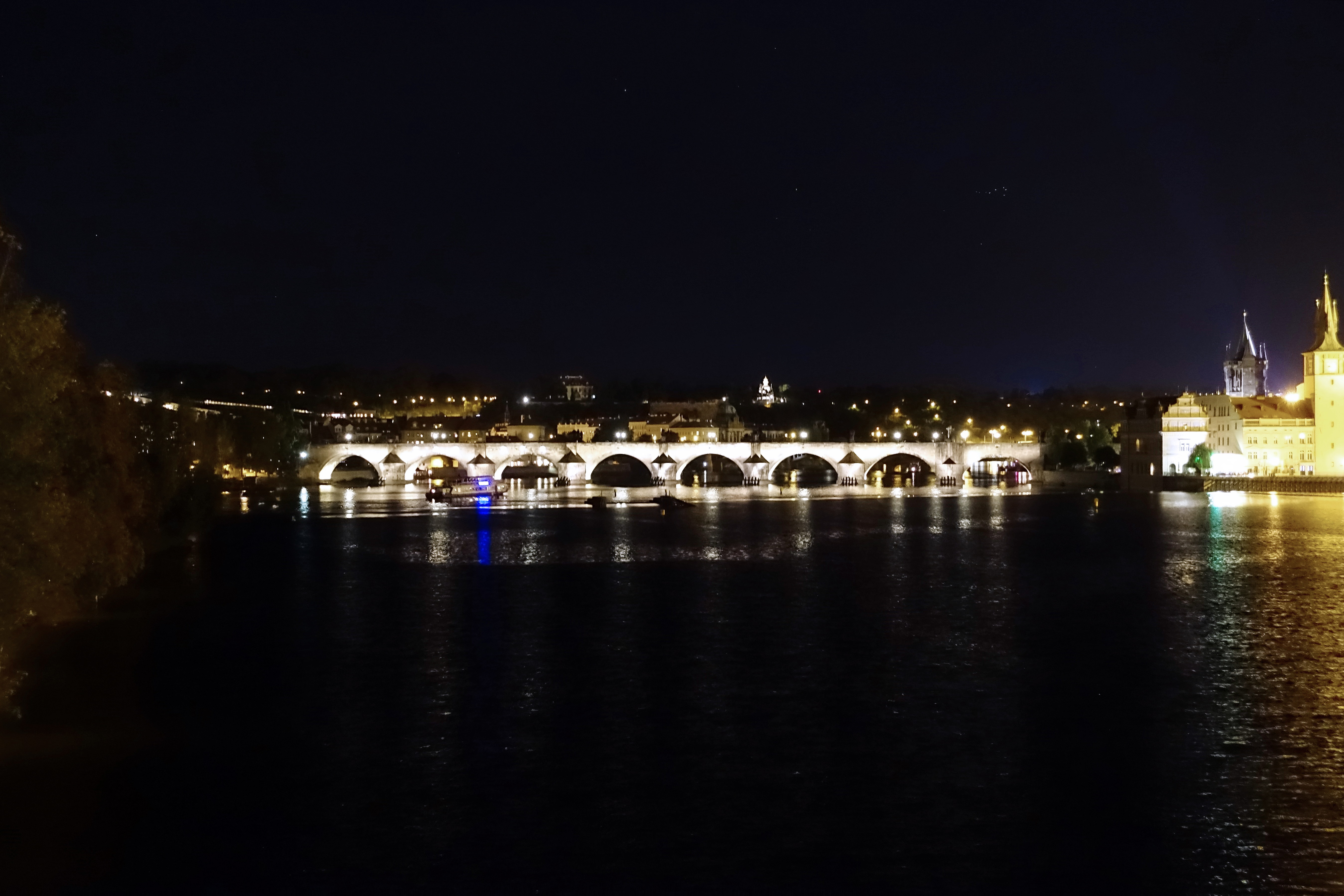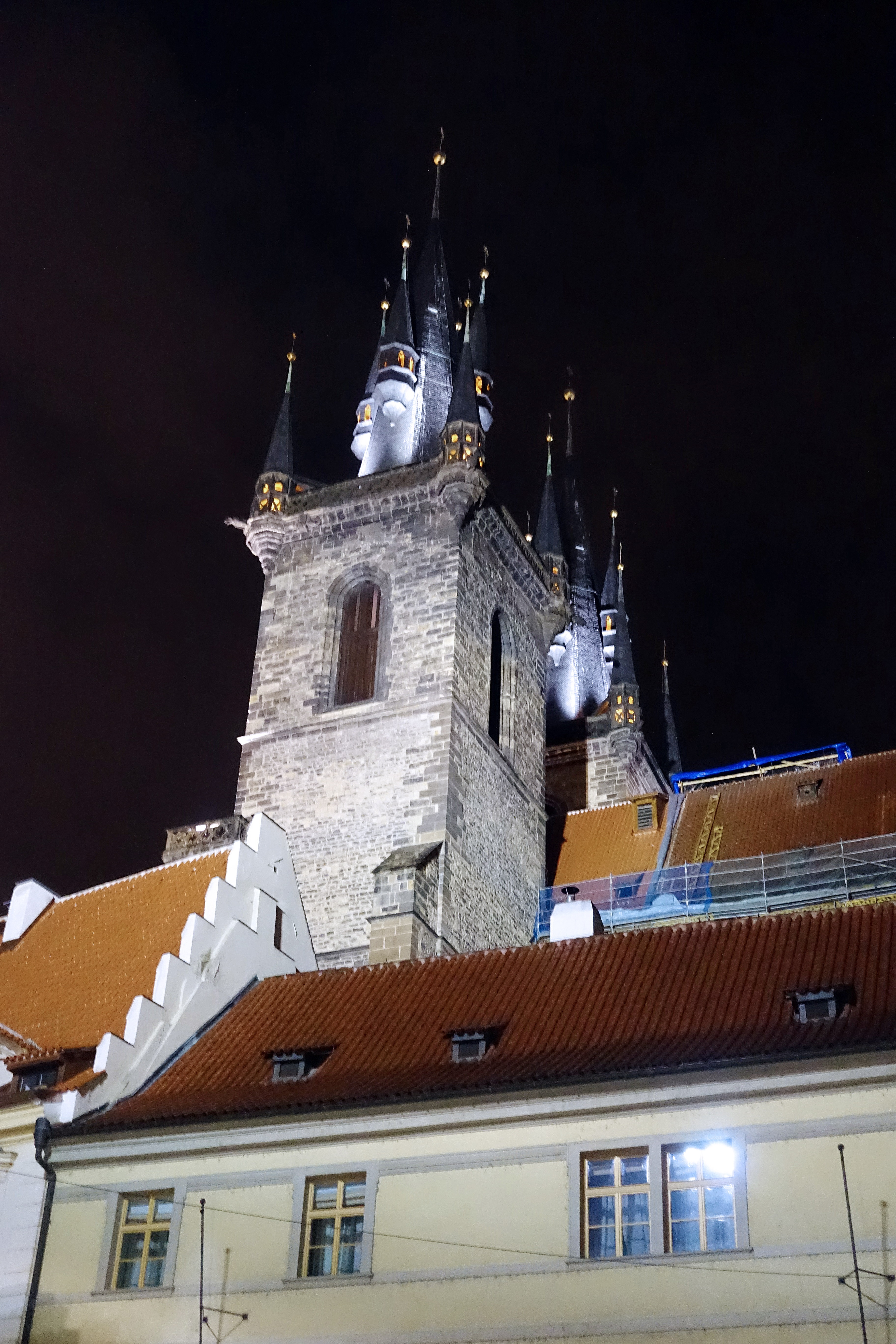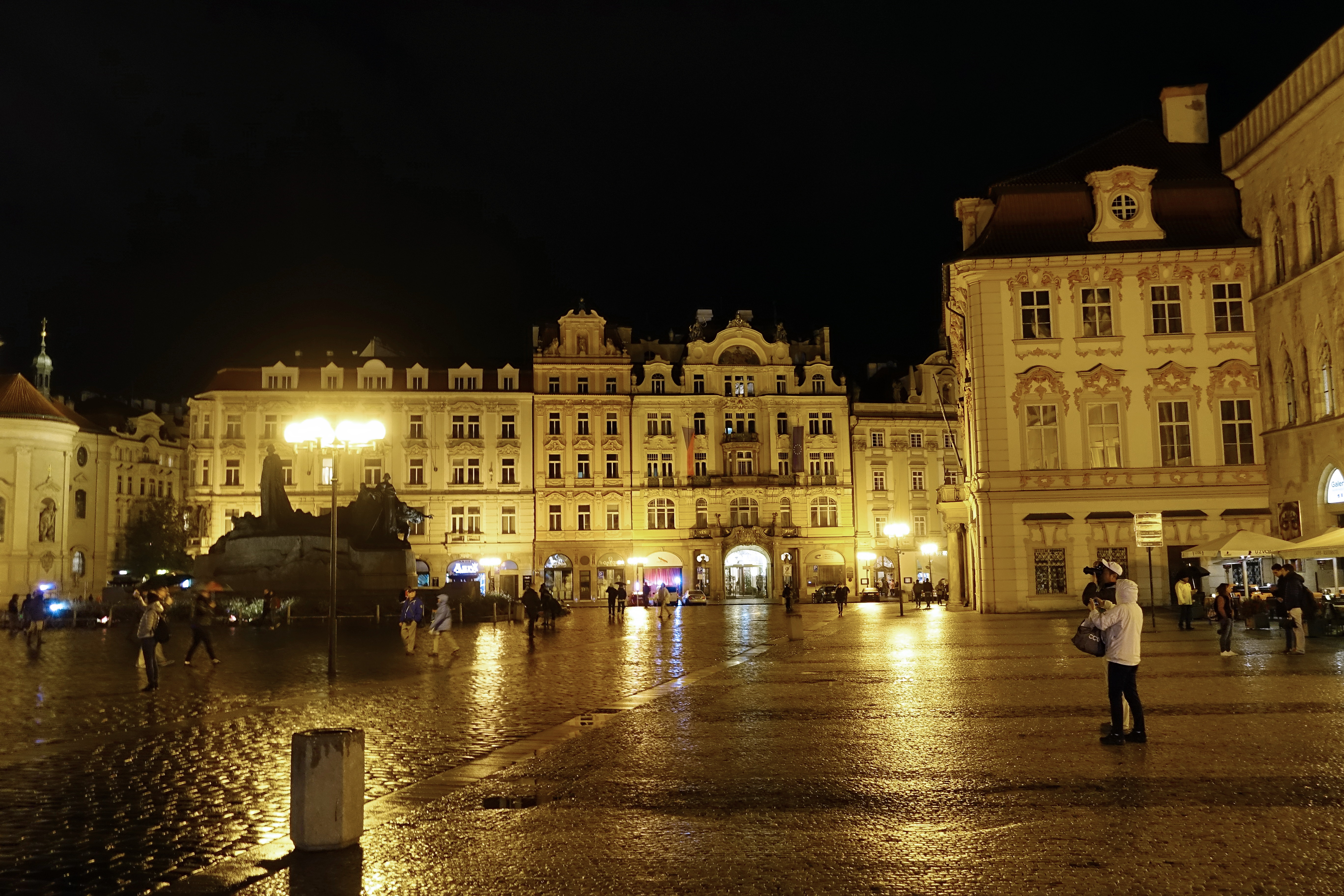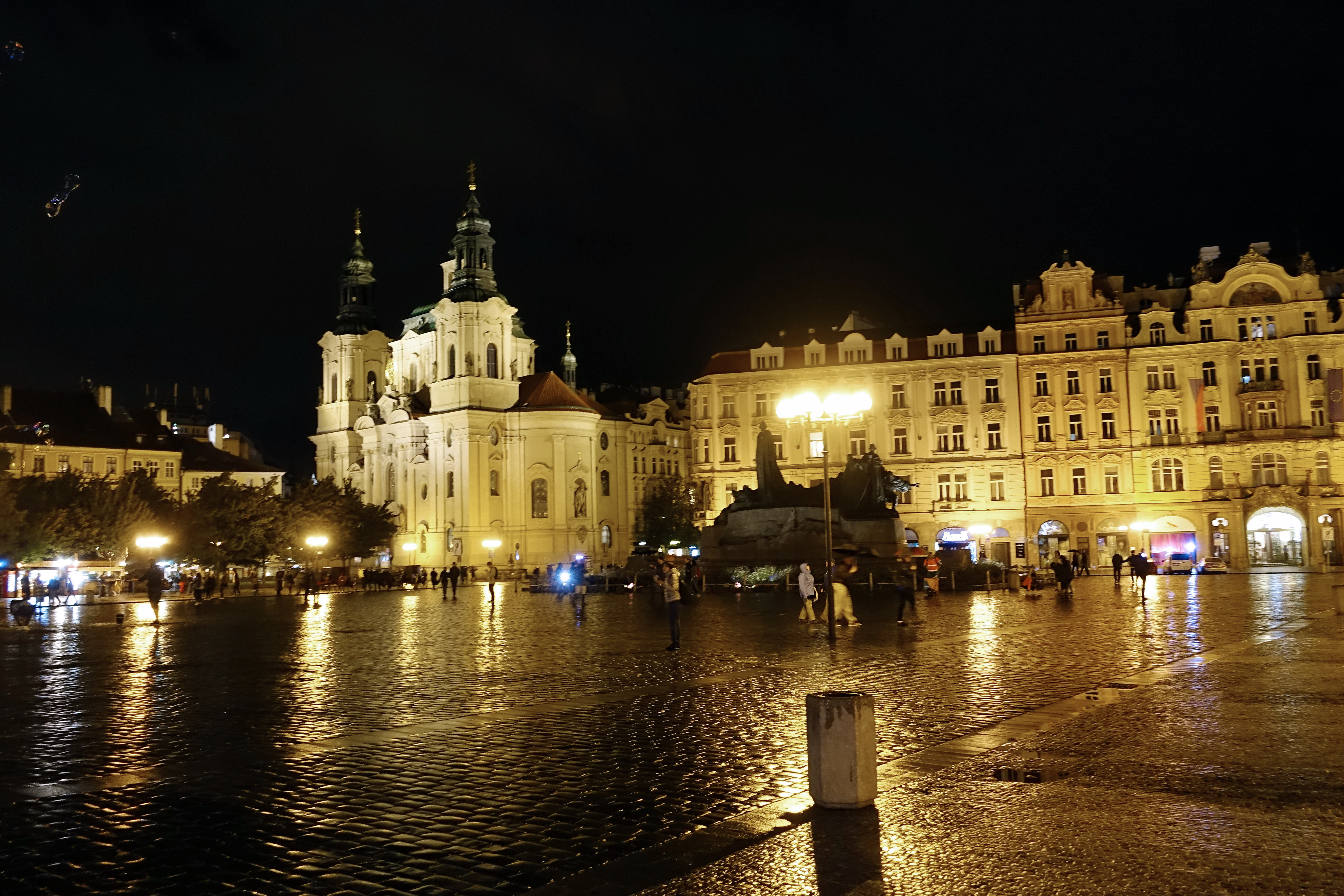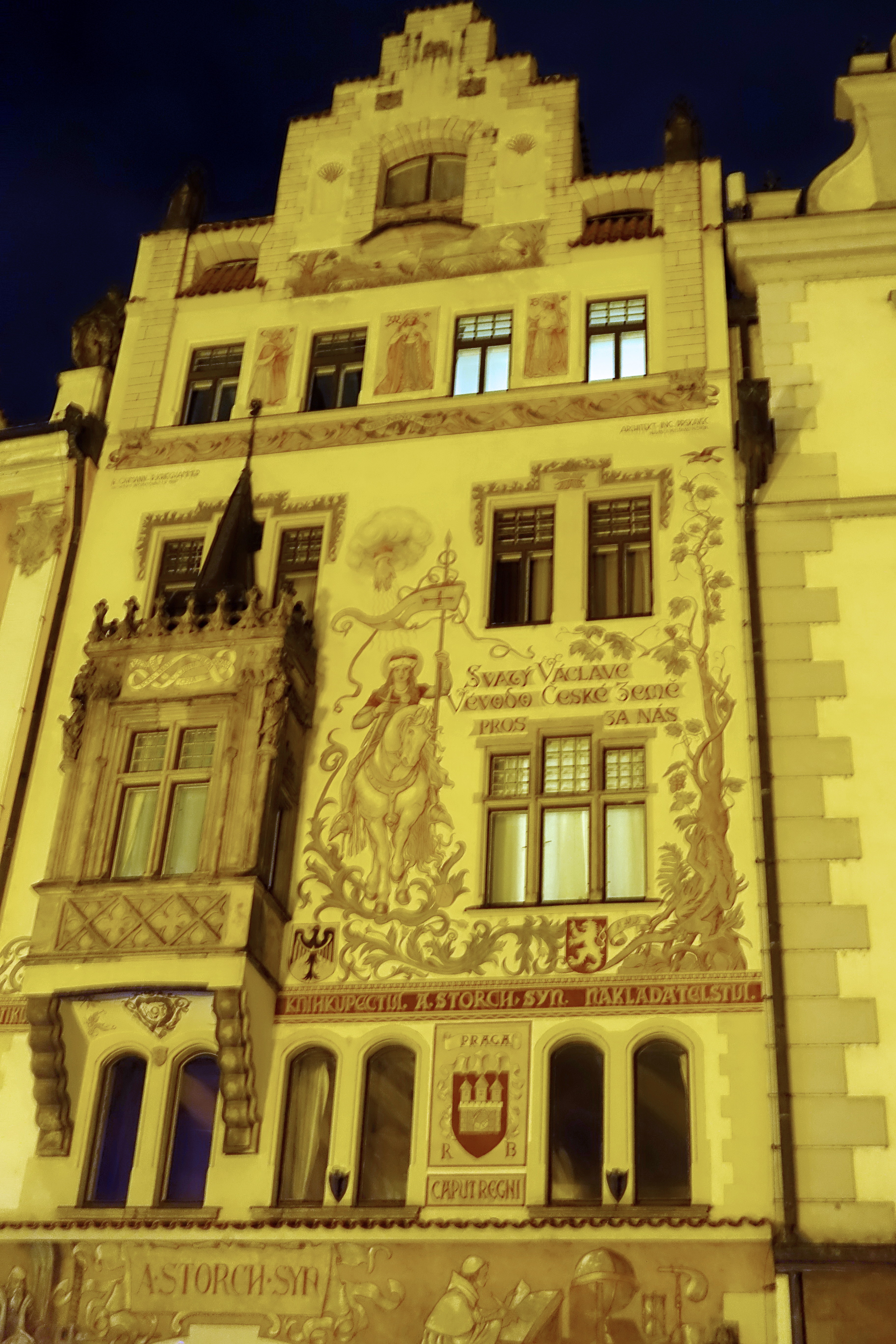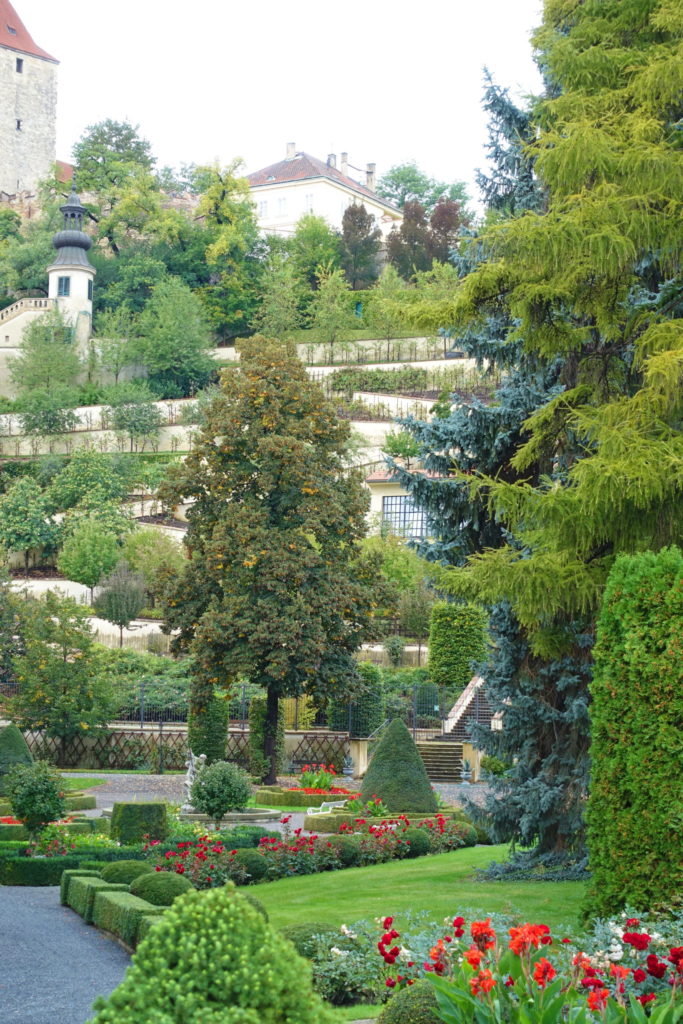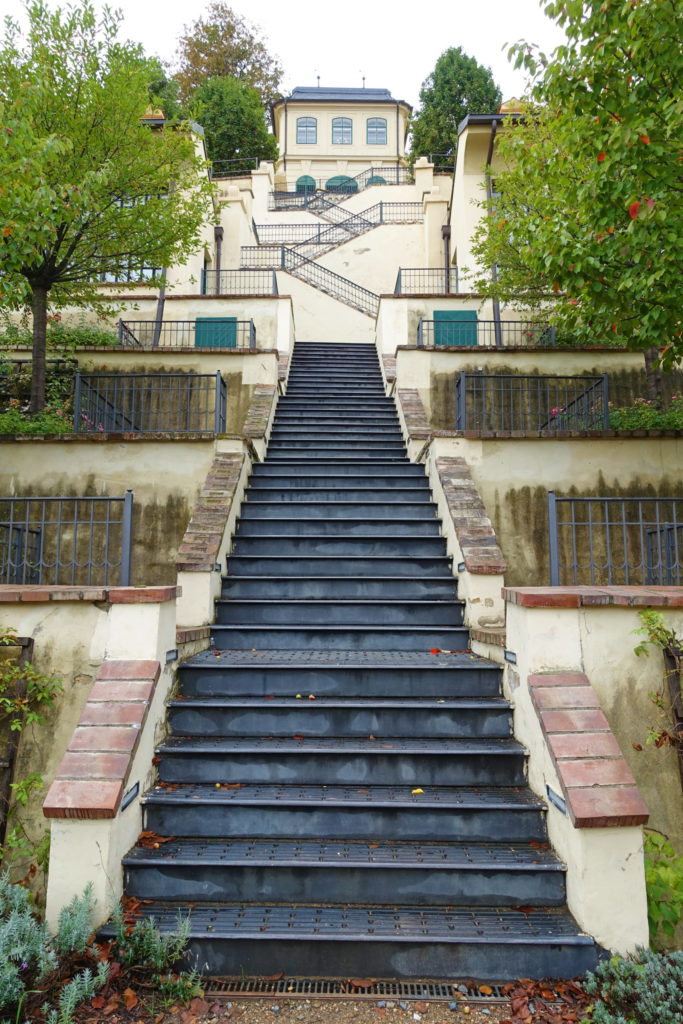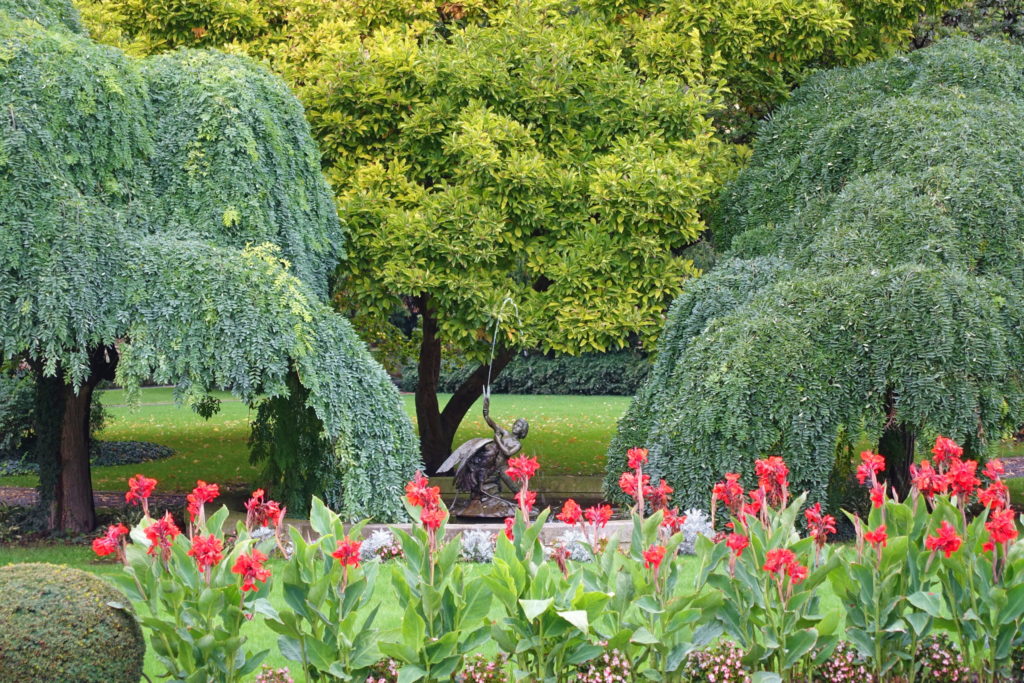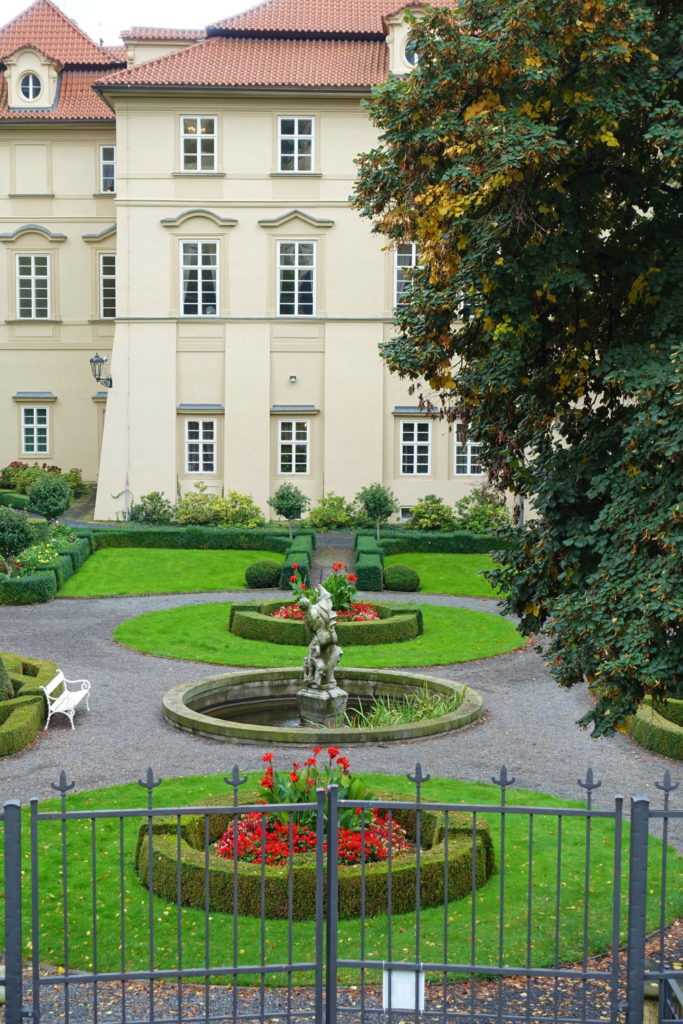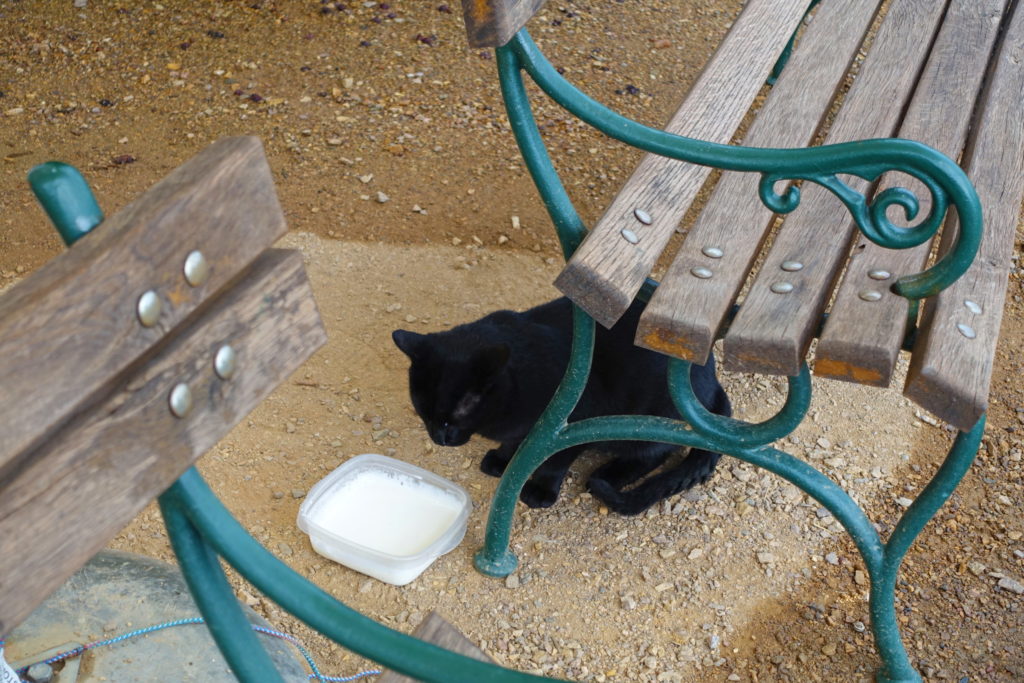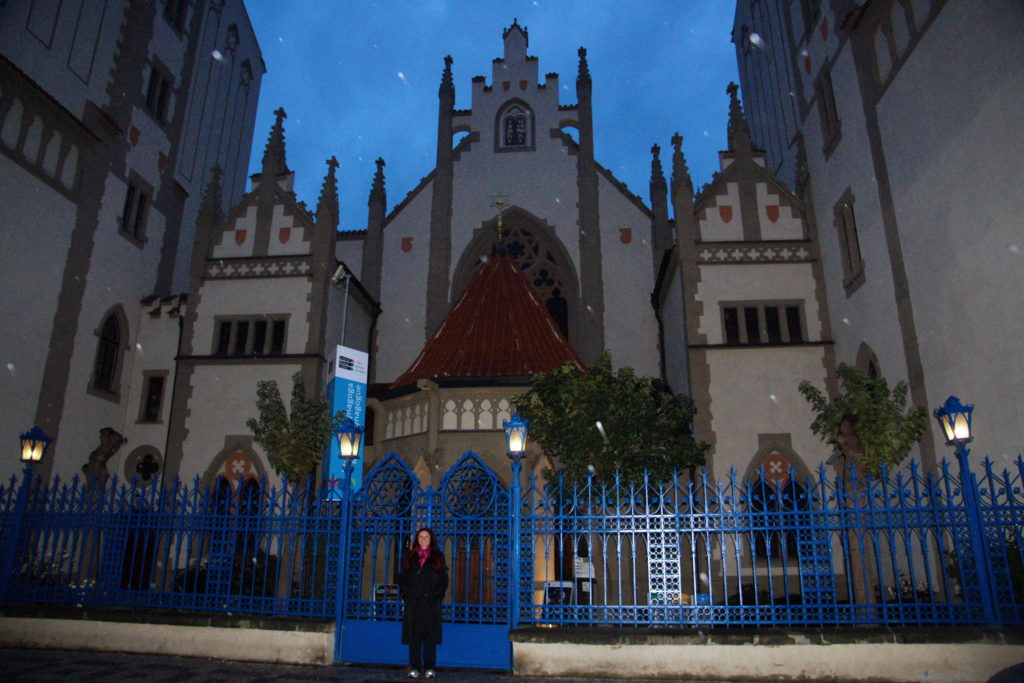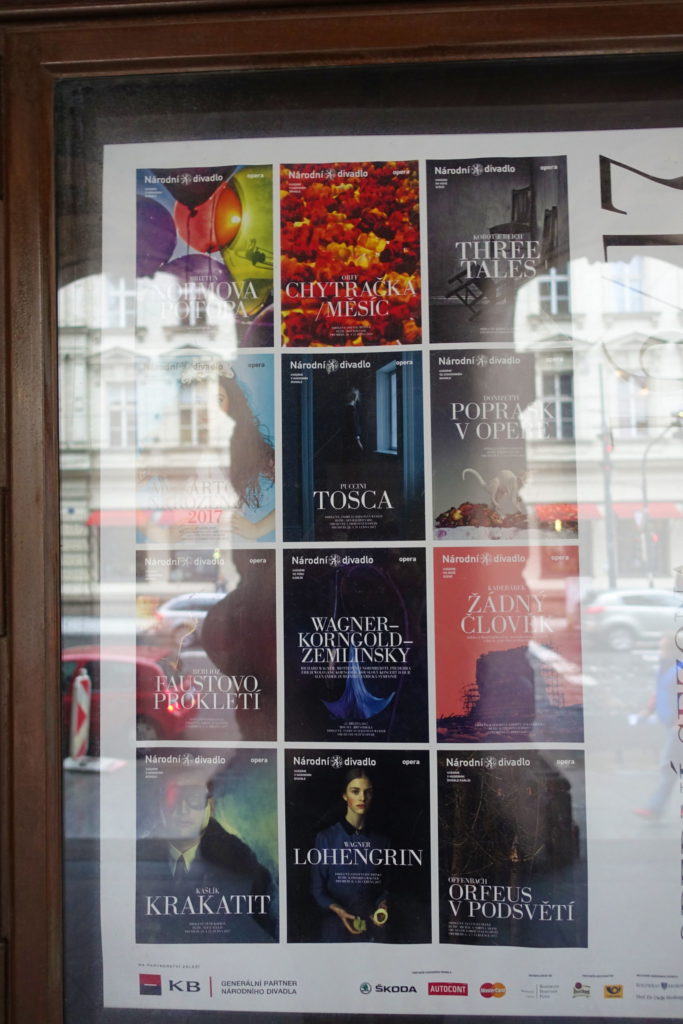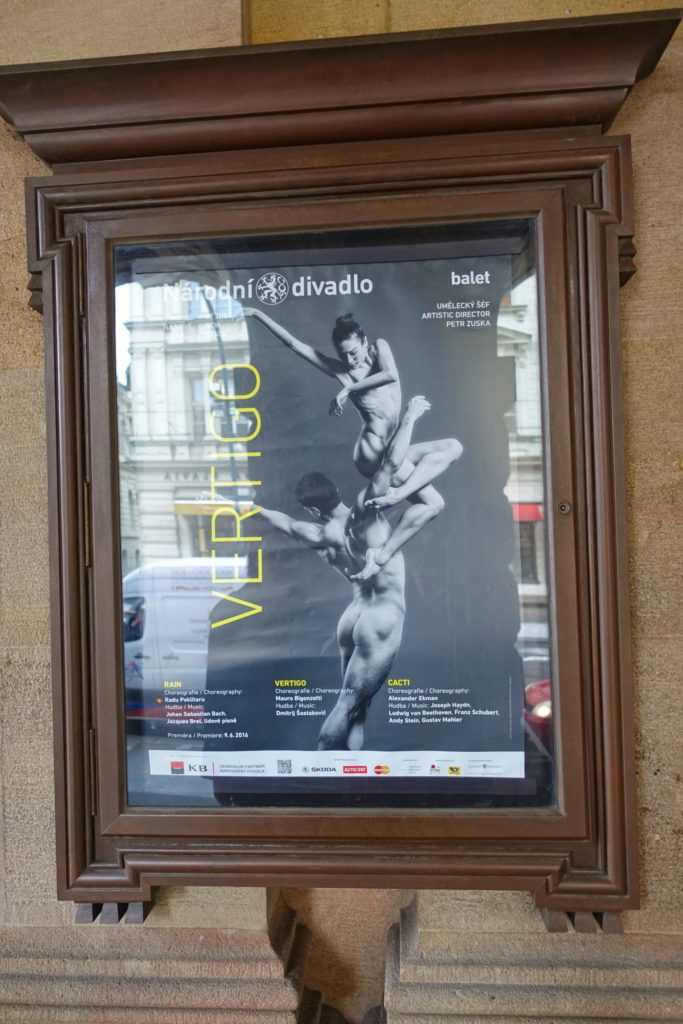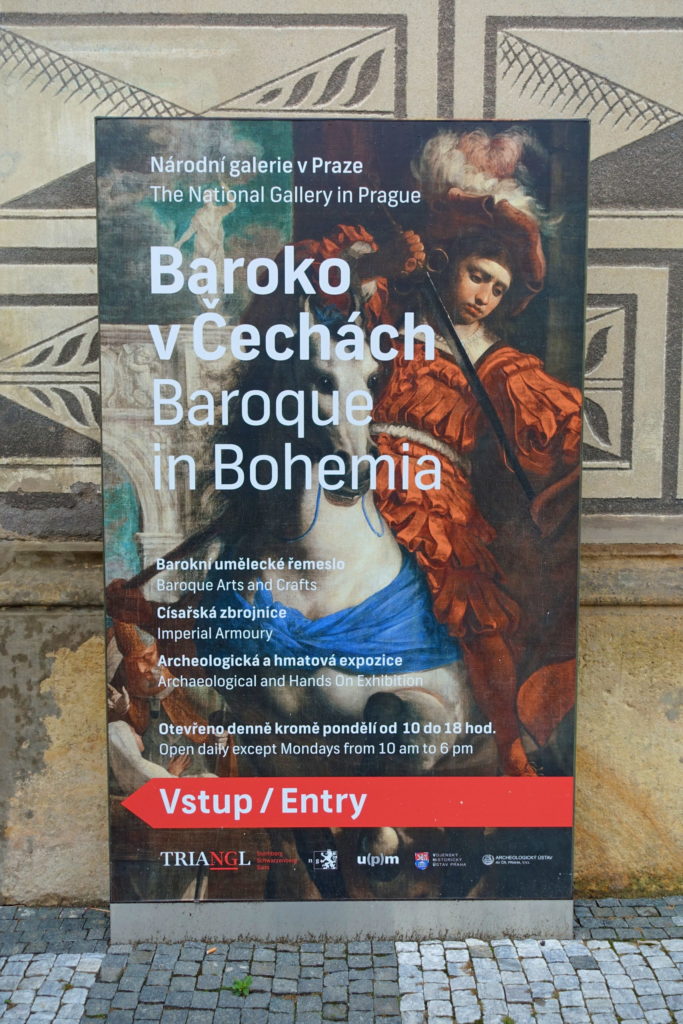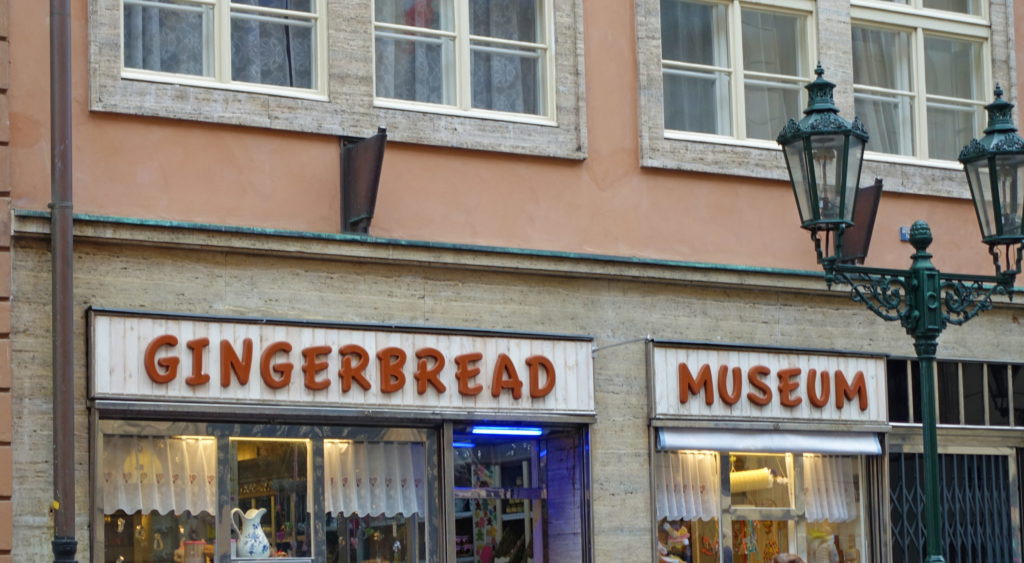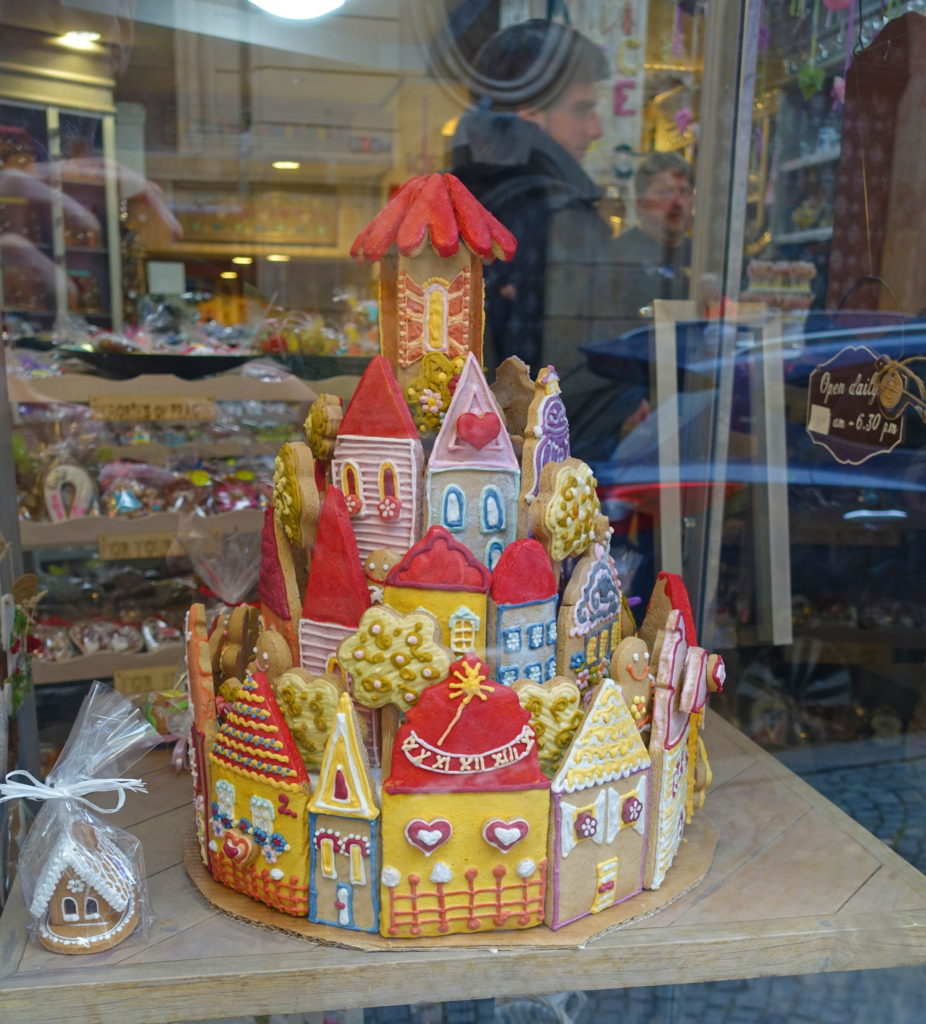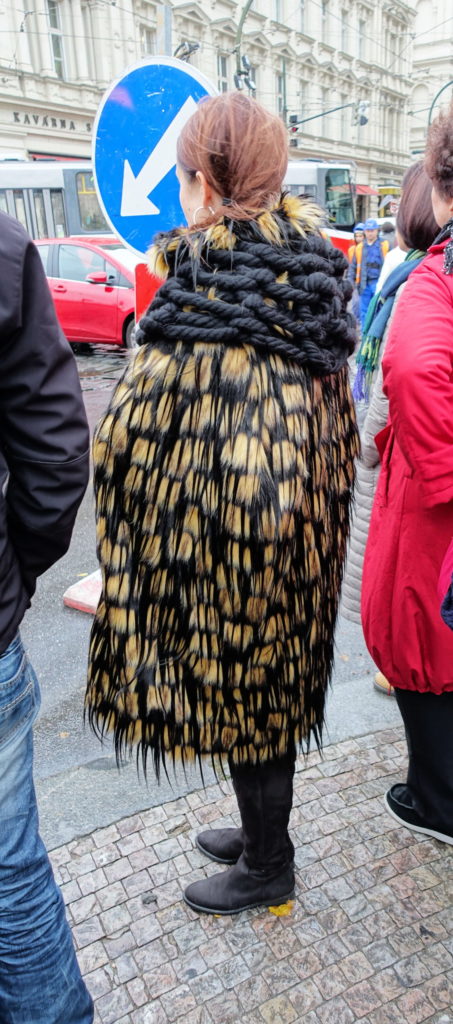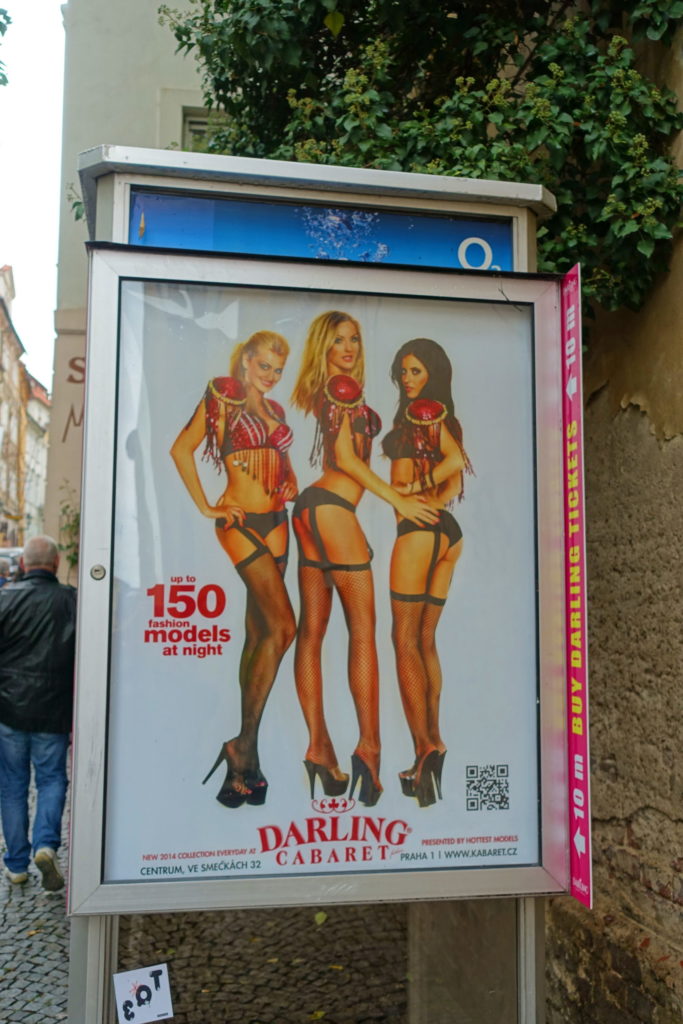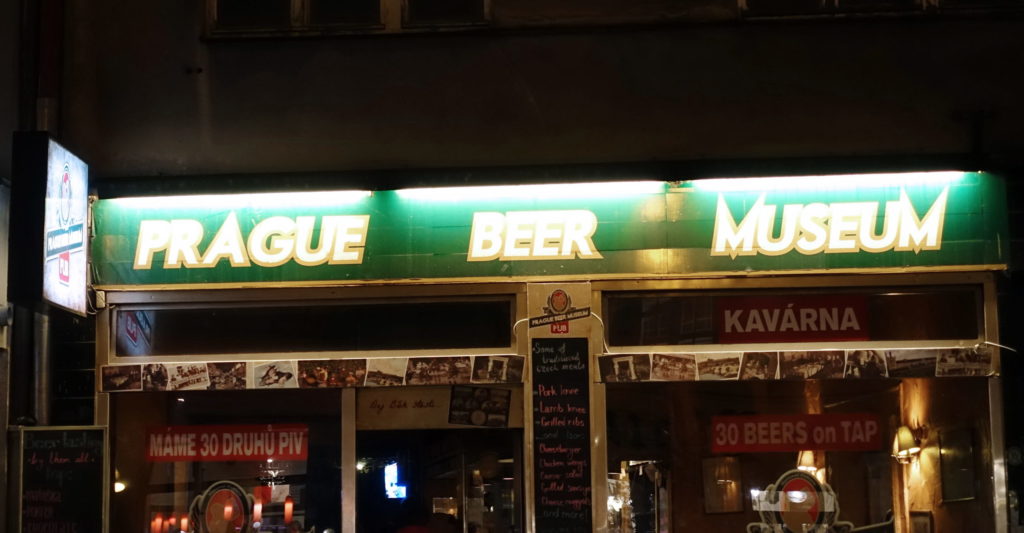According to legend, and according to Rabbi Dovid Solomon Ganz citing Cyriacus Spangenberg, Praha (or Prague in English) was founded on the shores of the Vltava river as Boiheam in about 1306 BC by king Boyya. Praha flourished in the Gothic, Renaissance and Baroque eras and is now home to 1.3 million residents. Praha was the capital of the Kingdom of Bohemia and the main residence of several Holy Roman Emperors, most notably of Charles IV (r. 1346–1378). It was an important city to the Habsburg Monarchy and its Austro-Hungarian Empire. The city played major roles in the Bohemian and Protestant Reformation, the Thirty Years’ War and in 20th-century history as the capital of Czechoslovakia between the World Wars and the post-war Communist era.
So let’s go visit this Alpha global city!
A statue by David Černý purported to be of Sigmund Freud keeps watch over the city. We wonder if it’s a lightning rod…
This might represent a bird in a wheeled cage. It might represent freedom, longing to escape. If you are attending University, it probably represents Man’s Inhumanity to Man. But if you back up and squint your eyes, it looks like an evil skull.
“Description of a Struggle” is one of Franz Kafka‘s longer minor works and is divided into three chapters. The first chapter is narrated by a young man attending a party and tells of his “acquaintance” (as he is referred to in the story) who he meets there. The second chapter is the longest and is itself split into several sections. The narrator leaps onto his acquaintance’s back and rides him like a horse and imagines a landscape that responds to his every whim. He then meets an extraordinarily fat man carried on a litter who tells him the story of a “supplicant” who prays by smashing his head into the ground. In the third chapter, the narrator returns to reality, so to speak, and continues his walk up the Laurenziberg in winter with his acquaintance.
This statue by Jaroslav Róna is a tribute to that story.
There is a statue in Prague called “Toileta” depicting a woman on a rock formation, her head turned to the right, holding a stream of hair with both hands. This is not that statue.
Prague has (at least) fourteen classical music venues, so it’s no surprise that classically-trained musician spill over into the street to entertain the masses.
Let’s look at other cool places and things in Praha. But first, check out the creepy puppet store. Yikes!
Panoramic Praha
Praha has survived many wars with few of its buildings destroyed by fire or bombs, the result of which is this tribute to marvelous architecture.
There are many places in Praha to take photographs of the city, including the towers on either side of the bridge. In the background is Prague Castle, which we will visit shortly!
Pražský hrad
Pražský hrad, or “Prague Castle” for those of you who have difficulty with the Czech language, is the largest ancient castle in the world, occupying an area of almost 70,000 square meters, at about 570 meters in length and an average of about 130 meters wide.
Prague Castle is the largest coherent castle complex in the world, with an area of almost 70,000 m².
Before the Berlin Wall symbolically fell, and for a few years afterwards, Prague Castle was easy to visit. A few idiots made bomb threats, and now there are controlled space, a lot of Policie České republiky, and tourist who wait as a mob before entering. We do this to ourselves, people.
A marching band passes, but all we hear are the clip-clop of their feet because the are practicing only the marching part.
Hradčanské náměstí, the square in front of Prague Castle, contains some of the Czech capital’s most notable historic buildings, including the cream-coloured Archbishop’s Palace, in the northeastern corner of the square. The palace has been the seat of Prague’s archbishops since 1562, when it was bought by Archbishop Antonín Brus of Mohelnice. The original palace, in the Lesser Quarter, was burnt down in 1420 by angry supporters of the Hussite movement, prompting Habsburg ruler Ferdinand I to have a Renaissance-style replacement built. Between 1764 and 1793 the Renaissance structure was given a Rococo makeover and acquired the form we see today; the main façade was the work of Jan Josef Wirch. The interiors are mainly Rococo; the most noteworthy features are a portrait gallery of Prague’s archbishops, and a collection of French tapestries
Today, the Archbishop’s Palace is the headquarters of the Catholic Church in Prague and is not open to the public. Sad.
The equestrian statue of Saint George is a bronze sculpture was created in 1373 by Hungarian sculptors Martin and George of Kolozsvár. It was originally erected in Buda castle and it was brought to Prague later, either during Louis I as a gift to emperor Charles IV, or during Rudolf II to protect it from the Turkish wars. The statue was made with the lost-wax casting method, and was turned into a fountain statue in the 16th century.
Tuscany Palace started being built in 1960 by Count Thun from Hohestein at a place where there were several houses owned by the Lobkowicz family. Count Thun planned to establish here, in the immediate vicinity of Prague Castle, his representative seat though he did not live long enough to see it finished. In 1718 the unfinished palace was bought by the Duchess of Tuscany – hence the name.
Bazilika Sv. Jiří (English: St. George’s Basilica) is the oldest surviving church building within Prague Castle. The basilica was founded by Vratislaus I of Bohemia in 920. It is dedicated to Saint George. The basilica was substantially enlarged in 973 with the addition of the Benedictine St. George’s Abbey. It was rebuilt following a major fire in 1142. The Baroque façade dates from the late 17th century. A Gothic style chapel dedicated to Ludmila of Bohemia holds the tomb of the saint. The shrines of Vratislav and Boleslaus II of Bohemia are also in the basilica. The abbess of this community had the right to crown the Bohemian queens consort.
The building now houses the 19th century Bohemian Art Collection of National Gallery in Prague and also serves as a concert hall.
In the center of the Second Castle Courtyard stands a large, richly decorated Baroque fountain, made in 1686 by J. Kohl and Italian stonemason F. della Torre. It is sometimes called the Lion’s Fountain (based on the lion statues on the pillar) or Leopold’s (after the emperor Leopold I under whose reign it was built). The top end sphere bears a golden plated Habsburg eagle until 1918. The fountain is supplied with water from an ancient water pipe, that brings water from the Brusnice stream and also from the pond below the Hvězda summer palace in Horní Liboc.
You can barely notice it in the photograph of the tourists mobbing in front of the castle gate, but the soldier’s little house is protected with a railing. That must make them feel pretty safe, right?
St. Vitus Cathedral
The Metropolitan Cathedral of Saints Vitus, Wenceslaus and Adalbert (Czech: metropolitní katedrála svatého Víta, Václava a Vojtěcha) is a Roman Catholic metropolitan cathedral in Prague, the seat of the Archbishop of Prague. Until 1997, the cathedral was dedicated only to Saint Vitus, and is still commonly named only as St. Vitus Cathedral.
Construction of the cathedral in its current form began on 21 November, 1344.
This cathedral is a prominent example of Gothic architecture and is the largest and most important church in the country. Located within Prague Castle and containing the tombs of many Bohemian kings and Holy Roman Emperors, the cathedral is under the ownership of the Czech government as part of the Prague Castle complex. Cathedral dimensions are 124 by 60 meters, the main tower is 102.8 meters high, the front towers are 82 meters high, and the arch height is 33.2 meters.
The first master builder was a Frenchman Matthias of Arras, summoned from the Papal Palace in Avignon. Matthias designed the overall layout of the building as, basically, an import of French Gothic: a triple-naved basilica with flying buttresses, short transept, five-bayed choir and decagon apse with ambulatory and radiating chapels. However, he lived to build only the easternmost parts of the choir: the arcades and the ambulatory. The slender verticality of Late French Gothic and clear, almost rigid respect of proportions distinguish his work today. Mr. Matthais died in 1352.
Around 1399, Wenzel Parler, Johannes Parler, and a certain Master Petrilk, the transept and the great tower on its south side were finished. So was the gable which connects the tower with the south transept.
In 1873, Josef Mocker assumed control of the reconstruction and designed the west façade in a typical classic Gothic manner with two towers,
Notice the gargoyles above the main portal of the western section. Those early Christians did not have the same delicate sensitivities of modern architects.
The richly sculptured portal created by the masons’ lodge under the leadership of Matthias of Arras forms the south-facing entrance into the cathedral that served the ruler and important dignitaries. The portal entrance is below the Royal Oratory. A coat-of-arms with the emblem of the Kingdom of Bohemia is places diagonally at the top of the sculptured pointed arch. There is a crowned double-tailed lion in relief on the coat-of-arms; a pot-shaped helmet with crest and mantlings is places above it as part of the cornice. The polychrome remnants are of a later date. The remains of the emblem of the Archbishopric of Prague can be seen on the left, partly covered by the impost of the more recent arch of the bridge to the oratory. A second impost destroyed or covered another emblematic coat-of-arms. The richly carved oak doors in the mannerist style were inserted into the Gothic portal in 1629. The figures portrayed in the central relief are Saint Peter, Saint Paul, and the Archangel Michael (of Catholic fame).
While the transept is impressive, it is only one part of the triple-naved basilica with flying buttresses, five-bayed choir and decagon apse with ambulatory and radiating chapels designed by the aforementioned Frenchman Matthais of Arras. That fellow kept no chains on his creativity.
There are many stained-glass windows in St. Vitus Cathedral, including this one in the Chapel of the Holy Sepulchre.
“Another of Karel Svolinsky’s incredible contemporary pieces is this window design featuring purple, red and pink glass presenting the ‘Works of Mercy’. There are two main categories of Mercy; corporal and spiritual. The Corporal works of mercy are; To feed the hungry, To give water to the thirsty, To clothe the naked, To shelter the homeless, To visit the sick, To visit the imprisoned, or ransom the captive and to bury the dead. Spiritual Works of Mercy is to instruct the ignorant, to counsel the doubtful, to admonish the sinners, to bear patiently those who wrong us, to forgive offences, to comfort the afflicted and to pray for the living and the dead. Each of these acts of mercy is thoughtfully represented in each frame of the window. The flowing natures of glass design adds a sense of movement to the entire piece which gives it that sense of modernity despite being over a hundred years old.”
“The Creation Rose Window is set into the western frontispiece. This was created by Frantisek Kysela in 1925 and took over two years to be completed. The inscriptions on the stained glass tell the story of creation as told in the Bible. The outer circle says, “in the beginning, God created the earth and the earth was empty. And deserted, darkness lay above the world, and the divine spirit floated above the world.” The inner circle says, “initially there was a word. The creation of angels.” From right to left, clockwise, each petal of the rose represents a day of the week and the parts of the earth which were created upon those days. God sits at the top of the rose window. Looking down upon his incredible creation. The shape of the rose window resembles the shape of the earth and the blues and greens caught within the design look like an image of earth from space.”
The architects used every opportunity they could find to add embellishments to their cathedral. I expect God is duly impressed with the iconography.
A French legend that sprang up around the name of St. Romanus (French: Romain; fl. c. 631–641 AD), the former chancellor of the Merovingian king Clotaire II who was made bishop of Rouen, relates how he delivered the country around Rouen from a monster called Gargouille or Goji. La Gargouille is said to have been the typical dragon with bat-like wings, a long neck, and the ability to breathe fire from its mouth. Multiple versions of the story are given, either that St. Romanus subdued the creature with a crucifix, or he captured the creature with the help of the only volunteer, a condemned man. In each, the monster is led back to Rouen and burned, but its head and neck would not burn due to being tempered by its own fire breath. The head was then mounted on the walls of the newly built church to scare off evil spirits, and used for protection.
But the cathedral is not just massive dimensions and gothic manifestations. Some folks find time to get married here or, at least, pose in a small doorway for a smooch. Awwwwwww.
Architecture of Praha
As long as we are looking at ginormous buildings, let’s take a look at other structures in Praha.
The House U Mladých Goliášů (also U Bechyňů or Bechyňovský) No. 527 is a Neo-Renaissance corner house in the Old Town in Prague 1 on the corner of Skořepka Street and Jilská Street. The house was built in the years 1888 – 1889 according to the design of a prominent Czech architect of the 19th century Antonín Wiehl . The author of the sgraffito designs is Mikoláš Aleš. The statue in the corner represents the Catholic God’s mother.
There is only so much anyone can know about the world, and I wish I knew more about building styles. But I appreciate the mixture of window styles, façade coloring, and the fact that there is a small garden on the rooftop patio.
The Schwarzenberg Palace (Schwarzenberský palác) is a superb example of the use of sgrafitto, where wet plaster is scraped away to create distinctive black and white patterns. Notable features of the interiors include Renaissance paintings from the sixteenth century, which represent mythological scenes. The palace is one of the most striking historic buildings in Prague and occupies a prominent position in Hradčany, on Hradčanské náměstí. The building is also notable for its black and white plaster walls.
The interior courtyard is most famous for selling Budvar ležák, 1/2 liter for Kč 49.00!
The palace was built between 1445 and 1567 for the aristocratic Lobkowicz family and changed hands several times over the centuries until the Schwarzenbergs, a powerful Bavarian noble family gained it in 1719. By the turn of the twentieth century they had abandoned their property, which later housed the National Technical Museum; after the Communist coup in Czechoslovakia in 1948, the palace became the Museum of Military History.
This is probably an example of architecture as art, but we can’t be sure. Whatever it is, it is pretty cool.
The Church of Mother of God before Týn is a Gothic church and a dominant feature of the Old Town of Prague. It has been the main church of this part of the city since the 14th century. The church’s two towers are 80 m high, and each tower’s spire is topped by eight smaller spires in two layers of four. From the Renaissance and the Baroque periods, an exceptionally interesting collection of carved tombstones and epitaphs has been preserved, including the 1601 tombstone of astronomer Tycho Brahe, a man of many noses who, conveniently, is buried at this same church.
Charles Bridge, famous for its brides, host a number of statues and is bounded on the Old Town side by the conveniently-named Old Town Bridge Tower. “This high-gothic tower was designed, like the bridge itself, by the distinguished master architect Petr Parléř guarding one end of the Charles Bridge is one of the most exquisite examples of gothic architecture in Europe. Its foundations were laid together with the foundations of the Charles Bridge. The blackened gate was completed in 1380 and forms part of the old fortification system of Prague, built to protect the Old Town against northern invaders. However, it also has an aesthetic value and with its unique sculptural decorations is part of the Royal Way.”
The Prague Astronomical Clock, or Prague Orloj (Pražský orloj), is a medieval astronomical clock located in Prague, the capital of the Czech Republic. The clock was first installed in 1410, making it the third-oldest astronomical clock in the world and the oldest clock still operating.
However, what we see here is the oldest part of the Orloj, the mechanical clock and astronomical dial, dates back to 1410, when it was created by clockmaker Mikuláš of Kadaň and Charles University professor of mathematics and astronomy Jan Šindel. The first recorded mention of the clock was on 9 October 1410. Later, presumably around 1490, the calendar dial was added and the clock facade was decorated with gothic sculptures.
Please enjoy more photographs of Praha at night.
Palace Gardens Below Prague Castle
On the side of Prague Castle opposite the main entrance are the Palácové zahrady pod Pražským hradem. The palace gardens below Prague Castle are a complex of several historic, interconnected gardens. It lies on the territory of the Lesser Town, on the southern slope of Hradčany Hill. Originally, they were built next to aristocratic palaces, and to this day the different character of the individual independently designed gardens is preserved, but the entrances from Valdštejnská Street and the Na Valech Garden are connected into one unit accessible to the public.
In the 16th century, the walls on the southern slope of Hradčany Hill gradually lost their defensive function and were therefore partially demolished. Land, gardens and vineyards were bought by the nobility and burghers. Over time, small utility gardens disappeared and large gardens began to emerge on the site. Already in 1580, today’s Fürstenberg Garden was created. The gardens were built as a Renaissance Italian type and served to relax and delight the owners of the adjacent palaces. The gardens were ravaged by the Swedes after the conquest of the Lesser Town on August 5, 1648. During its subsequent restoration, the gardens were already built in the Baroque style. Terraces with sculptures, monumental staircases, fountains, hall terraces, pavilions and galleries appeared in the gardens. The high terraces offer beautiful views of the Lesser Town and the cityscape.
Every few meters along the stairway is a path leading to the edge of the garden (on both sides) with an additional set of stairways. “The terraces are accessible by a combination of central and symmetrical staircases, red gray masonry is applied on the retaining walls.”
“Garden architecture is limited mainly to fruit trees and lawns.” And, as you can see, very peculiar statues.
“The large Pálffy Garden is architecturally more interesting. The lower two terraces are wider, the other has a small circular fountain in the middle and behind it a portal of a tunnel staircase with a sundial. The upper observation terrace is also accessible from the lower level by a tunnel staircase in the axis of the garden.”
We watch this happy fellow drink and drink and drink this delicious cream…then regurgitate it. Well, he was happy for a few moments anyway.
Cultural Praha
Lying at the heart of Europe, Prague is one of the continent’s finest cities and the major Czech economic and cultural centre. The city has a rich architectural heritage that reflects both the uncertain currents of history in Bohemia and an urban life extending back more than 1,000 years.
Maisel Synagogue (Maiselova synagoga) is one of the historical monuments of the former Prague Jewish quarter. It was built at the end of the 16th century which is considered to be the golden age of the ghetto. Since then its appearance has changed several times, its actual style is neo-gothic. Nowadays the synagogue belongs to the Jewish Community of Prague and is administered by the Jewish Museum in Prague as a part of its expositions.
The National Theatre (Národní divadlo) in Prague is known as the alma mater of Czech opera, and as the national monument of Czech history and art. The National Theatre belongs to the most important Czech cultural institutions, with a rich artistic tradition, which helped to preserve and develop the most important features of the nation–the Czech language and a sense for a Czech musical and dramatic way of thinking.
They even have a dress code: By their appearance, attire and behaviour, the audience is obliged to adhere to the accustomed practice expected from them when attending a theatre performance.
Sadly, we are unable to see this performance of Vertigo. Even if the performers wear costumes, we are still interested to discover how the woman is being supported.
The Národní Galerie Praha is a state-owned art gallery in Prague, which manages the largest collection of art in the Czech Republic and presents masterpieces of Czech and international fine art in permanent and temporary exhibitions. The collections of the gallery are not housed in a single building, but are presented in a number of historic structures within the city of Prague, as well as other places. The largest of the gallery sites is the Trade Fair Palace (Veletržní Palác), which houses the National Gallery’s collection of modern art. Other important exhibition spaces are located in the Convent of St. Agnes of Bohemia, the Kinský Palace, the Salm Palace, the Schwarzenberg Palace, the Sternberg Palace, and the Wallenstein Riding School. Founded in 1796, it is one of the world’s oldest public art galleries and one of the largest museums in Central Europe.
“The Gingerbread Museum is a fragrant stop in the center of old Prague. Here you’ll find the largest sales exhibition of Czech gingerbread. All the gingerbread on offer is handmade, and will delight with its aroma and taste. It makes the perfect gift for friends and loved ones – just choose from the many shapes and patterns, or just stop by to gather inspiration for your home baking.”
As you can see, Gingers in Czech have a much higher standard of living than Gingers in the rest of the world.
A designer conceived of this coat, a garment maker crafted it, a shop displayed it, a customer purchased it, and this woman is wearing it. Beyond that, I have no comment.
Although we appreciate long legs, the mood is destroyed when the legs look comically long. The shoulder pads probably help shield the ladies from harm when they tip over and fall.
Pivo
Much of the brewing history of the Czech capital is connected to the various monasteries in the city, with brewing first recorded at the Benedictine Břevnov Monastery in 993 AD. It is also recorded that in 1088 AD, King Vratislav II granted a tithe of hops to the Canons of Vyšehrad Cathedral in order to brew beer. Today the Prague brewing scene is quite diverse, with Staropramen being the only industrial brewery. There is a total of 40 breweries and brewpubs, the oldest among them being U Fleků, which was founded in 1499 and has been brewing beer ever since. Most of the other breweries and brewpubs have been established in the city post-1989 and especially, post-2000.
Although brewed in Germany at the Eschweger Klosterbrauerei, Duff Beer is a popular choice in Prague.
The Prague Beer Museum is more than a museum. They sell 30 beers. “We founded Prague Beer Museum, a place to bring the best beers we found. Without existing infrastructure, creating the first pub in Prague to have 30 Czech craft beers on tap, was challenging. One of the beers we could only get when a friend of the brewer was visiting his girlfriend in Prague. As long as they don’t break up… we’ll have his beer.”
While beer drinking may be low-brow in some parts of America, the Europeans see things differently, and we agree.
When done well, beer is a lady’s drink. Cheers!

